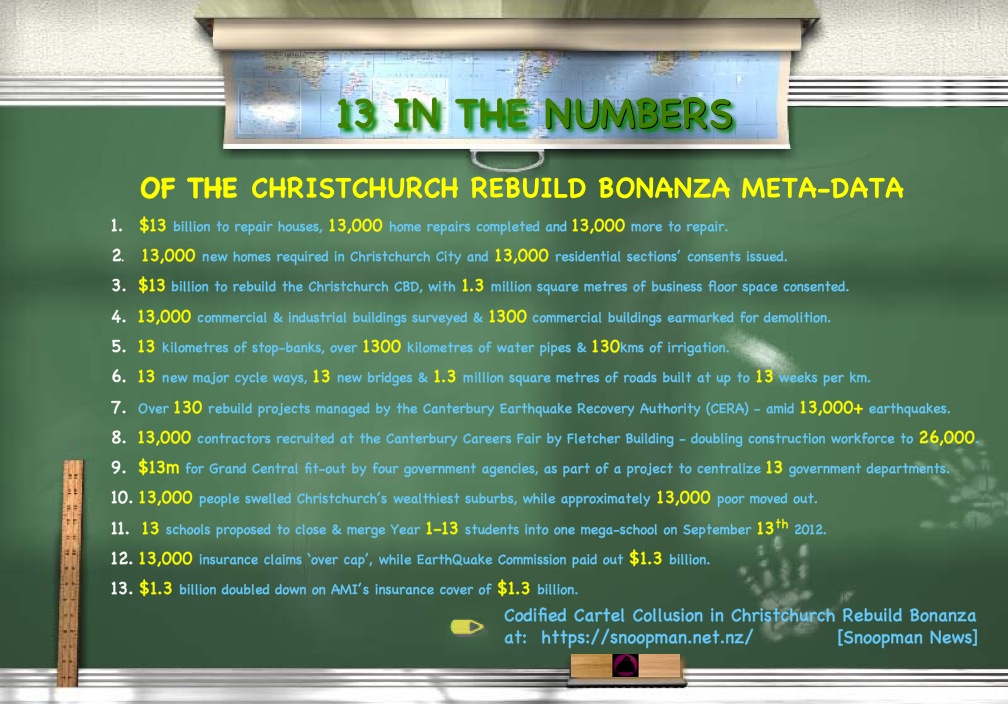The Curious Recurrences of Prime Number Thirteen among Neo-Colonial Old Boys’ Network during Canterbury Earthquakes and Aftershocks
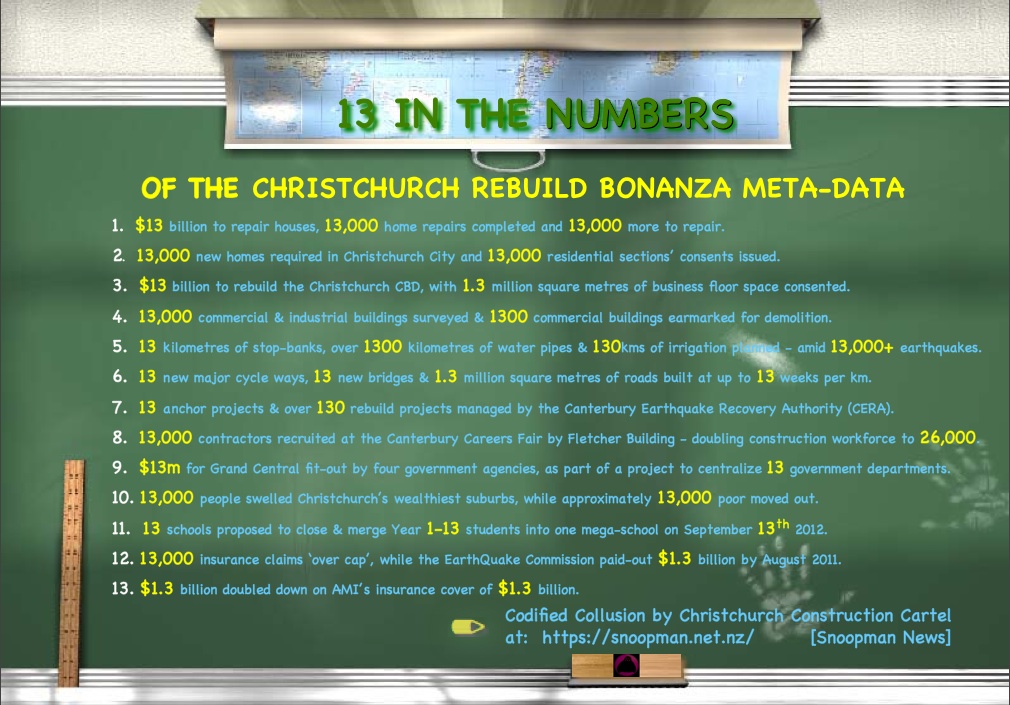
Amid the Christchurch Earthquake after-shocks, the Christchurch Rebuild projects drew criticism that cronyism, collusion and corruption was occurring between the Christchurch City Council, the New Zealand Government and a big business ‘alliance’ called Stronger Christchurch Infrastructure Rebuild Team (SCIRT).
A deeper dig into the Christchurch Rebuild meta-data reveals the hidden ‘hand’ of an Old Boys’ Network, whom operated as a cohesive cartel. This Christchurch Construction Cartel codified their communications to signify unity, caution and cues for scape-goating to resolve the inevitable scandals with a prime number – 13 – as weird as that sounds. Brazenly, ‘Thirteen’ and its multiples and variants were embedded into the key figures of rebuild projects, associated dates and economic data.
Their swaggering behaviour and performance was consistent with accomplices colluding as a cohesive cartel. By deploying the recidivist character ‘Thirteen’ in plain sight with a chameleon casting, New Zealand’s Neo-Colonial Patriarchy were able to locate one another across public and private sector institutions, communicate the advancement of ‘the game’ and inflict a Shock Doctrine cartel business model – with impunity.
This investigation concludes that the cohesion of this Pākehā-dominated Patriarchy was robust enough to withstand even well reasoned critiques that tabled examples of cronyism, collusion and corruption. Absent a tectonically damaging exposure of the Pākehā-dominated Brotherhood, the recidivist character ‘Thirteen’ and its ‘Accomplices’ will likely remain at-large, free to continue re-offending, limiting genuine market competition and maintaining an unfair, unsafe system where Patriarchal Cronyism exploits crises.
By Snoopman

The Shock Doctrine
Snapshot: Amid the Christchurch after-shocks, a Shock Doctrine cartel business model was applied to the rebuild and is detectable in the recurrence of the number 13 in the meta-data.
In her groundbreaking 2007 book, The Shock Doctrine: The Rise of Disaster Capitalism, Naomi Klein shows how dominant capitalist coalitions work with governments to exploit speed as a weapon to capitalize on crises, whether natural or human-made. In disaster – and while most are in a state of shock – property is sold at distressed prices, restrictive laws of broad scope are passed and huge reconstruction contracts are allocated either with public money or grants of land. Meanwhile, off-grid solutions to build-in genuine resilience, self-sufficiency and sustainability citywide are foregone.
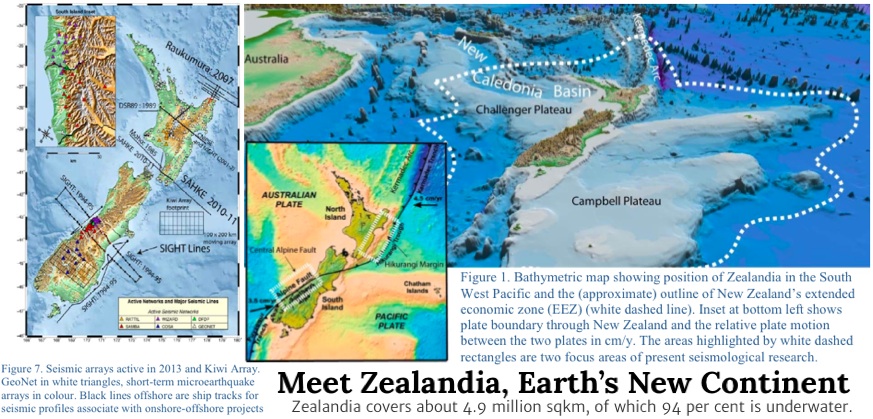
The idea that the shock doctrine had, in effect, become ‘applied economics’ to the Christchurch central city ‘blueprint’ for a post-earthquake rebuild was explored in an article headlined, “The Business INC of NZ” in The Press of Christchurch in mid-September 2012.[1] Some of the people interviewed believed the government and big business interests colluded to capitalize on the catastrophe.
A Christchurch Earthquake Rebuild Nexus was operating as a cartel with the complicity of central and local government — as John McCrone found reporting for the Christchurch Press in September 2012), with his article “The Business of NZ Inc,” — although he didn’t use the C-word, while he cited Naomi Klein’s, The Shock Doctrine. While Sarah Miles’ “Christchurch Fiasco” thesis, found the insurance industry exploit disasters to maximise profits. The data of the Christchurch Rebuild data, revealed that big corporate interests — foreign and domestic — worked hand-in-glove with central and local government as a hidden ‘brotherhood’ signalling their cooperation to collude by embedding the number 13 and its multiples in the rebuild meta-data.
In keeping with the Shock Doctrine, NZ PM John Key exploited the power of his office to announce a rebuild blueprint live on television – the result of a ‘100 days’ project in which a select cluster of architects and urban planners redesigned the central business district of Christchurch, in the region of Canterbury, New Zealand.[2] Subsequently, the Canterbury Earthquake Recovery Authority (CERA), its offshoot Christchurch Central Development Unit (CCDU) and the Christchurch City Council formed a visible ‘alliance’ with big business representing the construction industry. Participants gave their ‘alliance’ a deceptively banal name, the Stronger Christchurch Infrastructure Rebuild Team (SCIRT), which was designed to sound like a positive collaboration between the state and local government and business, while skirting the in-built collusion.
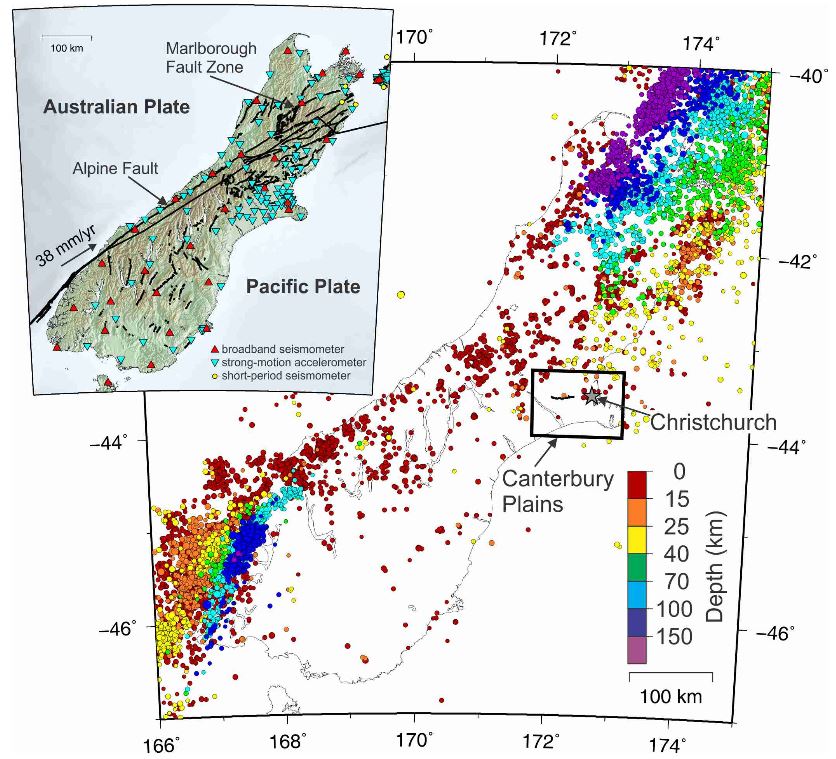
Following the magnitude 7.1 Darfield Earthquake in Canterbury, New Zealand, on 4 September 2010, the magnitude 6.3 Christchurch aftershock of 22 February 2011 that killed 185, injured approximately 5,800 and damaged over 100,000 homes was devastating. Then-Prime Minister John Key stated at the time, “[w]e may be witnessing New Zealand’s darkest day.”[3] During the peak of the clean-up phase, a volunteer group recruited 13,000 students and became known as the ‘Student Volunteer Army’.4] By the years’ end – the earthquakes’ economic costs were estimated at 13% of New Zealand’s GDP.[5]
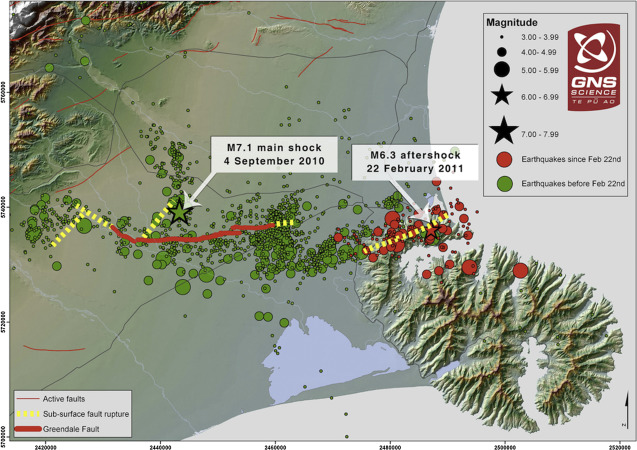
A deeper dig into the Christchurch recovery and rebuild meta-data yields exquisite codified communications – that belie an underbelly of cartel business practices.
The prime number ‘Thirteen’ was found to masquerade in mundane meta-data as dates, quantities and locations in insurance claims, engineering projects and news of redevelopment progress – or the lack thereof.
For instance, when a mundane statistic appears by itself – such as the above-cited earthquakes’ economic costs that were estimated at 13% of GDP by the end of 2011 – its villainy is lost in the unfolding theatre of government, corporate and media reports. Even the ‘Student Volunteer Army’, with its 13,000 students volunteering at its peak, seems to have been colonized as a potential recruiting ground. But – who would be capable of penetrating, manipulating and harvesting a fresh, politically naïve and enthusiastic youthful cohort?
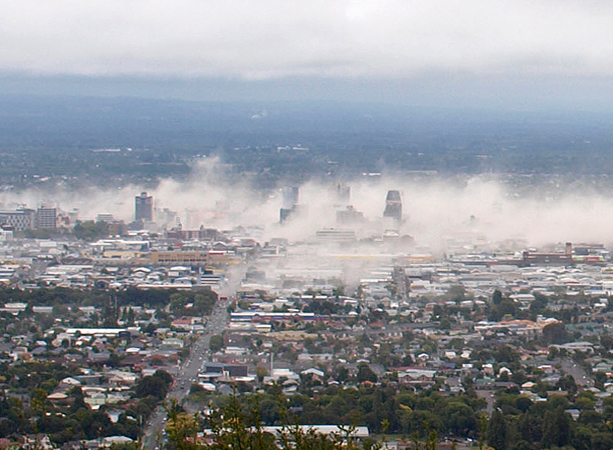
The recidivist recurrence of the number 13 – and its multiples or variants – work together like covert ‘accomplices’ and are the key mechanism for members of a hidden Old Boys’ Network to find, communicate and work with each other. This Old Boys’ Network, or Brotherhood, use the prime number 13 as a self-referential code – as weird and conspiracy theory as it sounds.[6] To key insiders who can read the unfolding narratives as the game of collusion advances, such loaded data signifies solidarity, communicates caution, and codifies scape-goating cues to resolve the underlying suppressed crises, avoid scandals escalating into full-fledged crises, or to brazenly engineer catastrophes to trigger a reset of a jurisdiction threatened with serious challenges to the ruling class and its super-rich oligarchy. Such collusion requires cronyism to distort the allocation of resources away from community-based cooperatives, community-owned resources and community-run villages that would otherwise build off-grid, decentralized infrastructure, services and enterprises.
Instead, future public funds – in the form of taxes on labour property income or ‘remuneration rates’, council rates or real estate property income taxes, and regressive taxed incursions into the common peoples’ commerce such as the Goods and Services Tax – were committed to the Christchurch Construction Cartel and their associated accomplices via uneven, unfair and asymmetric crony state insurance payouts, private insurer disbursements and public-private partnership deals. Meanwhile, resources to conduct sustained investigations, convict culprits and signpost serious solutions were foregone. This covert use of ‘Thirteen’ in the Christchurch rebuild bonanza has a context among the world’s brotherhoods. The prime number 13 symbolizes ‘unity and fraternal love’, and is deployed for ‘procuring marriage agreements’, as occultists Aleister Crowley stated in his book, Liber 777, and W. Wynn Westcott asserted in his work, Numbers: Their Occult Power and Mystic Virtues.[7]
The self-referential exhibition by key insiders whom encoded their communications during the Christchurch recovery and rebuild stages includes: global engineering firm, Aurecon; engineering and construction firm, The Gough Group; Fletcher Construction and Fletcher Building; the Canterbury Earthquake Recovery Authority (CERA), the Christchurch City Council; the EarthQuake Commission, insurer AMI; and N.Z. Government Ministers – among many others.
Not to be outdone, the tectonic plates clocked up 13,000 earthquakes and aftershocks between September 3 2010 and September 2012, as the EarthQuake Commission’s GeoNet reported.[8] This figure was widely gazetted in subsequent government, corporate and media reports – even as late as February 2019 by Xinua News,[9] despite the number of earthquakes and aftershocks rising to 17,000 by January 2017.[10]
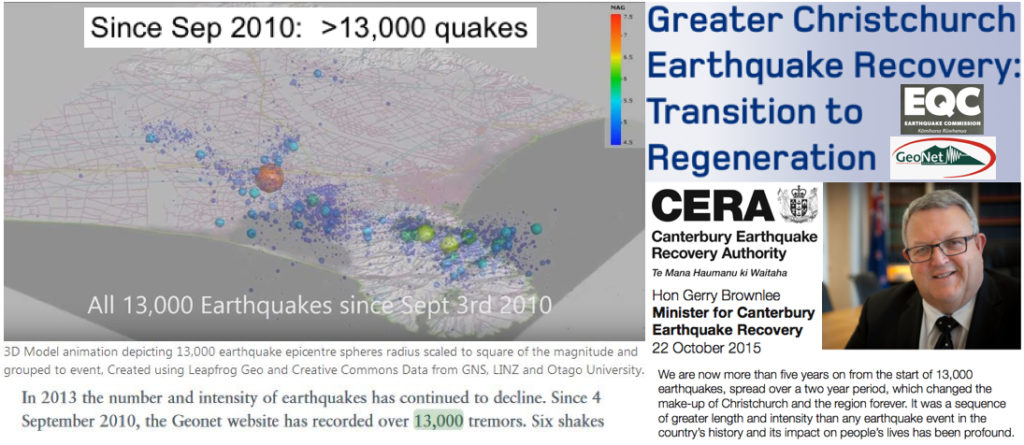
Although Klein’s Shock Doctrine thesis does not mention this prime number as a phenomenon, her thesis can work as a ‘lens’ to show the Brotherhood’s ‘hand’ advancing their moves, as game theory could predict. In game theory, ‘posting a hostage’ is a mechanism to construct stability and is predicated on a provisional promise to cooperate if other players post hostages too. In their paper, “Resolving social conflicts through hostage posting: theoretical and empirical considerations,” Gideon Keren and Werner Raub noted that “tacit communications of threats and promises are two major message strategies used to influence the behaviours of others”.[11] Therefore, ‘the game’ requires an implied threat, which signals a defection on the next move if the other player does not post a hostage too. A cohesive cartel system can influence strategies, monitor rivals, punish defections and enforce tacit agreements to undermine existing competitors and limit new market entrants by price-setting, quality chiseling and product standardization – that would otherwise not be legally enforceable via Court edict, Council regulation or Crown legislation.[12]
With game theory awareness, the recidivist Thirteen’s villainous masquerading in mundane statistics is revealed by its brazen recurrence in the disaster capitalism meta-data itself.
Key Finding: Absent the occult dimensions, Canterbrians could see that the Shock Doctrine being applied to the Christchurch Earthquake rebuild was actually consistent with disaster capitalism.

Recidivist Thirteen
Snapshot: The rebuild data reveals the ‘hand’ of the Old Boys’ Network whom codified their communications to signify solidarity, cue caution and gazette scape-goating rituals with the prime number - 13.
For instance, six months after the 22 February 2011 earthquake, the EarthQuake Commission paid out $1.3bn[13] and found 13,000 claims were ‘over cap’, meaning private insurers were also liable.[14] AMI doubled down on its insurance cover of $1.3 billion.[15] In mid-2012, the Medical Assurance Society reported 13 commercial properties written off.[16] At the end of September 2014, insurance companies had $13 billion paid out to settle $8 billion in commercial claims and $5 billion in residential claims, announced Insurance Council’s Chief executive Tim Grafton.[17] By August 2016, EQC paid out $13 billion for the commercial property reconstruction of the Christchurch, reported Peter Townsend, who was the chief executive of the Canterbury Employers’ Chamber of Commerce, and who also doubled as a director of Ōtākaro Limited, which was overseeing the CBD’s 13 Anchor Projects and Precincts.[18]
The Canterbury Earthquake Recovery Authority (CERA) re-zoned approximately 1300 White–coded properties to Green to initiate repair.[19] CERA also signaled 1300 commercial buildings might be demolished, and subsequently were by 2016.[20] The more precise number was, evidently, 1339 buildings by 2016. That is, a cute capstone figure completed the original estimate of 1300 – since 13 x 3 equals 39.[21] The Christchurch CBD was allocated a budget of $13 billion.[22] CERA issued a notice that 13,000 commercial and industrial buildings in the greater Christchurch area would be surveyed.[23] In a Cambridge University study, 1113 GPS photos of damaged and destroyed buildings were taken.[24] A new justice precinct was designed to concentrate 1300 workers in an area of the CBD next to the new central bus terminal.[25] And the Christchurch City Council granted land for a new $13 million Canterbury Museum to ‘house’ the Wakefield’s art collection.[26] In a 13 to four vote count, the Christchurch City Council moved to appropriate $10m in property taxes to help fund the $105 million rebuild of the Anglican Christchurch Cathedral, which left a shortfall $13 million for the Anglican Church to stump up.[27]
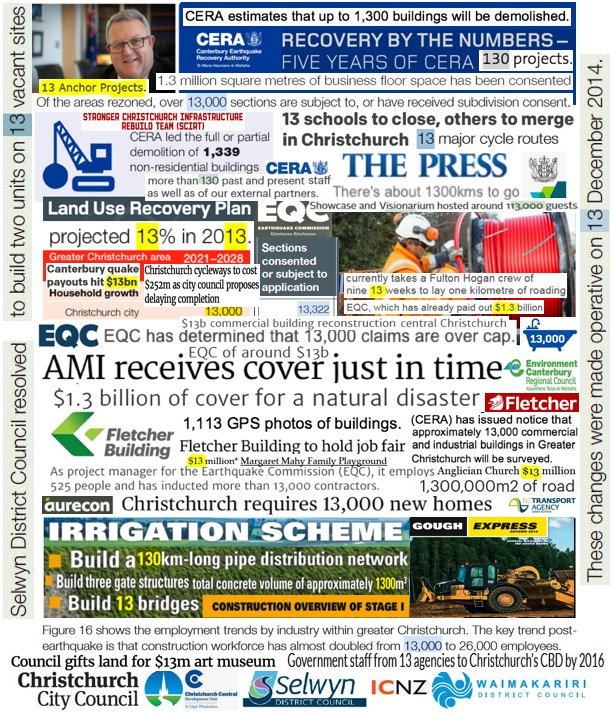
Also in the numbers, on September 13th 2012 Education Minister Hekia Parata proposed closing 13 schools.[28] A media pack was handed out at around 11.30am, and a video played that included a plan to merge one school into a Year 1-13 mega-school.[29] Some of the schools earmarked for closure had only minor damage, which subsequently confused the good people of Christchurch, and the now-defunct current affairs program, Campbell Live.[30]
Rebuild projects emphasized 13 in the statistics, such as Fletcher Building whom estimated a $13 billion bill to repair houses,[27] reported 13,000 home repairs completed[28] and 13000 to be done.[29] Christchurch evidently required 13,000 new homes.[30] Fortunately, the Neo-Colonial Patriarchy’s Brotherhood – and doubtless, numerous underpaid, unwitting ‘sisters’ on the scene – were on hand to process 13,000 residential sections’ consents in rezoned subdivision areas, or more precisely 13,322 applications.[31] Industriously, Fletcher Building ‘inducted’ 13,000 contractors at a Canterbury Careers Fair,[32] a feat that magically caused the construction workforce to double from 13,000 to 26,000.[33] It was, therefore, lucky that in the Selwyn District, the symbolically named Minister of Housing and Development, Lockwood Smith, unlocked 113 hectares of land.[34] In the first six months following the Christchurch Earthquake of 22 February 2011, average house prices across Christchurch increased by 13% (amid a supply-side induced sales slump).[35] Magically, Christchurch house prices maintained this buoyancy, and were found to have risen 13% between the pre-earthquake month of August 2010 and March 2013.[36]
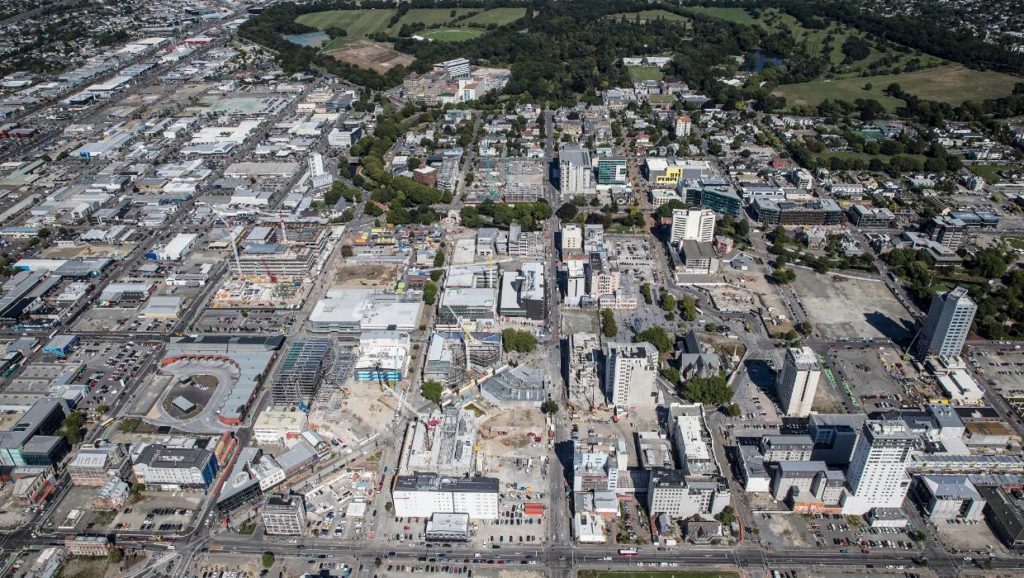
Canterbury Earthquake Recovery Authority Minister Gerry Brownlee helped Christchurch recover by claiming more than 1300 comments were received on the Christchurch Metro Sports Facility.[37] The Department of the Prime Minister and Cabinet also telegraphed statistics of Patriarchal Cronyism, Collusion and Corruption when it gazetted in September 2015 that around 113,000 guests had visited the Visionarium and Showcase facilities, which displayed Christchurch Rebuild Projects, in the previous 12 months.[38] And the EarthQuake Commission reported 13,000 people had visited its Earth Rocks! exhibition.

By the time CERA was disestablished, it had overseen more than 130 projects,[39] and its subsidiary the Christchurch Central Development Unit had managed 13 key Anchor Projects and Precincts.[40] The intriguing rebuild meta-data also records that Christchurch businesses gained council consent for 1.3 million square metres of business floor space between February 2011 and December 2014.[40] Also in the numbers were over 1300 kilometres of water pipes,[41] 1300m of gravity pipes,[42] 13 kilometres of stop-banks,[43]1300 kilometres of ultra fast broadband cable remaining to be laid,[44] a 130km irrigation project,[45]13 bridges to be built,[46] while road-laying took road-builder, Fulton Hogan, up to 13 snail-pace weeks per kilometre.[47] Unfazed, Fletcher Construction boasted 1.3 million square metres of roads had been constructed.[48] Meanwhile, the Christchurch City Council was excited about 13 new major cycle ways.[49] Until, the cost predictably ballooned to $252 million, an exquisitely cute capstone figure that topped the estimate figure. By applying numerology, the budget blowout of $252 million rendered down to 13 by dividing the full deck of cards number – 52 – in 2 to yield 26, and by slicing this Cycling Cake into two Crony halves, two prime cuts of the meaty number Thirteen were harvested.[50]
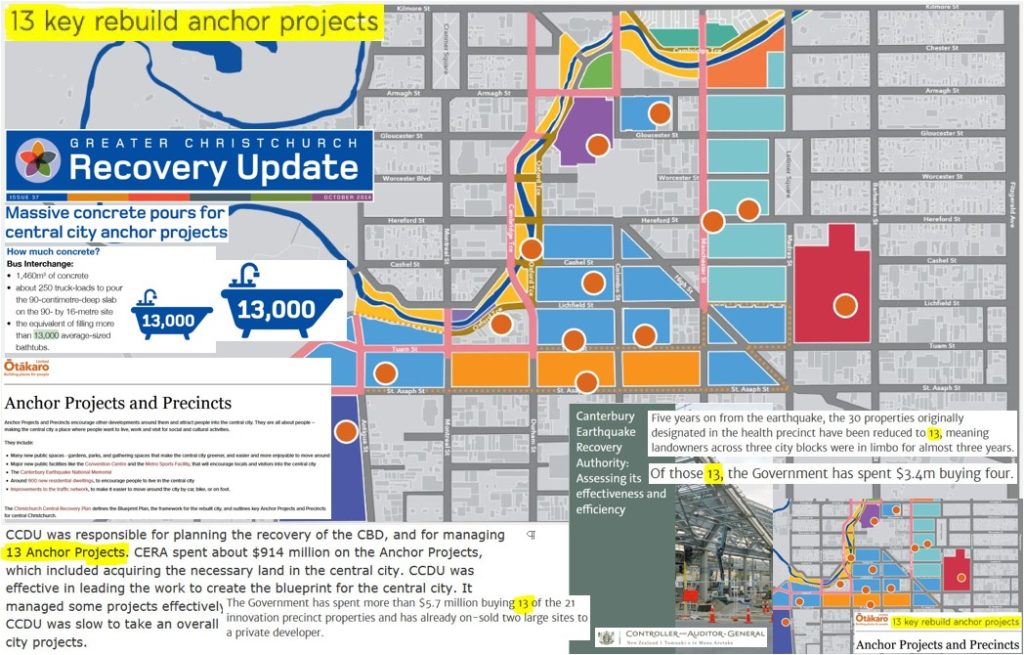
The website for Ōtākaro Limited – which is the Crown-owned entity for purchasing land and merging titles, in conjunction with CERA and CCDU – does not explicitly state that there are 13 Anchor Projects and Precincts.[17] 13,000 bathtubs worth of concrete slabbing were required for the Bus Interchange, which is one of the 13 key Anchor Projects in the Christchurch Central Business District.

Even the children of Christchurch were not spared from being drawn into the Christchurch Construction Cartel’s collusion. Innocently, children shared their ideas for a playground named after a prolific and famous New Zealand children’s author, the late-Margaret Mahy. The $13 million playground project, which includes a slide of 13 feet wide, was a joint venture between CityCare Civil and John Fillmore Contracting. The design team included design consultants, Opus, landscape architects, Boffa Miskell, Māori tribal council, Te Rūnanga o Ngāi Tahu, playground equipment supplier, PlayRope, and the Christchurch City Council.
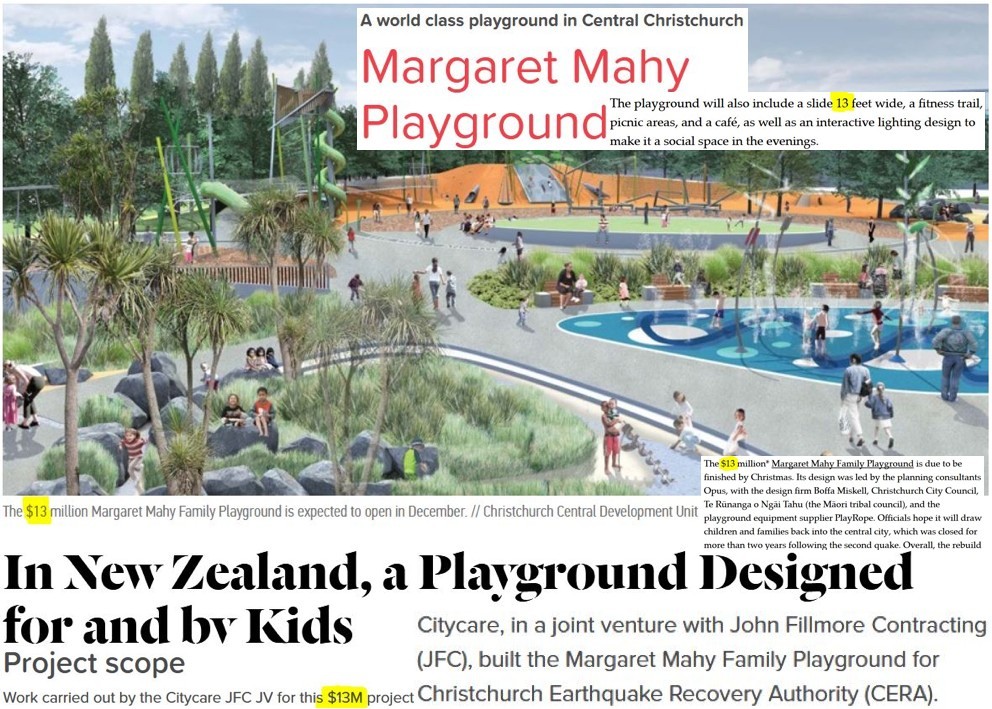
Key Finding: The Christchurch Rebuild data reveals a Neo-Colonial Patriarchy deploying the recidivist prime number Thirteen to advance a game of cartel collusion – lest defections occur.

Resilient Thirteen
Snapshot: The chameleon cast of Thirteen and its Accomplices adapted to the crisis during the rebuild and recovery phases with 'resilience' personas – to fit in with the Rockefeller Foundations' 100 Resilient Cities New World Order Utopia Project.
In the aftermath of the Christchurch and Canterbury earthquakes, aftershocks and tremors, a New Zealand Health Survey studied 13,000 adults nationally, including approximately 1000 Christchurch earthquake-experienced respondents, to construct a Canterbury Wellbeing Index, in collaboration with the Canterbury Earthquake Recovery Authority (CERA).[51] Fascinatingly, global accountancy firm, Deloitte, reported that Canterbury’s Gross Regional Product (GRP) was 13% of New Zealand’s total,[52] which was lucky because the earthquakes were estimated to have cost the economy 13% of its Gross Domestic Product (GDP).[53]
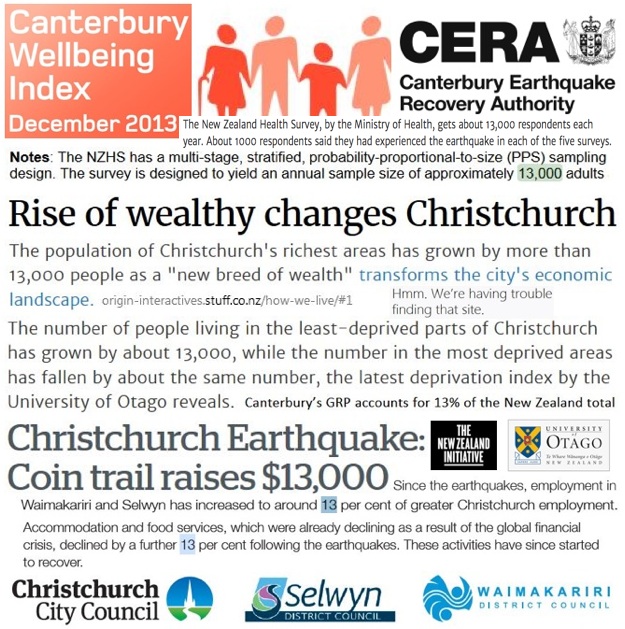
In 2013, Christchurch was selected as one of 33 cities for a 100 Resilient Cities Project spearheaded by the New York-based Rockefeller Foundation as part of its Global Centennial Initiative. According to the Rockefeller Foundation’s fairy-tale brainwashing, the Global Centennial Initiative was launched to mark 100 years since one of America’s leading industrial cartel oligarchs, John D. Rockefeller, started the Foundation on May 14, 1913, evidently “with the goal of ‘improving the well-being of humanity throughout the world’.” On September 13th 2016, the Christchurch City Council signed the ‘Resilience Pledge’ and earmarked 10 percent of the city’s 2017/2018 expenditure to allegedly build the city’s resilience.[54] The 100 Resilient Cities initiative supposedly seeks to address chronic stresses like unemployment and inefficient or overtaxed public transport, and acute shocks like earthquakes, floods and terrorist attacks.[55] This ostensibly wholesome Rockefeller Foundation initiative is ironic given that when the super-rich David Rockefeller was chairman of the New York-based Council on Foreign Relations (1970-1985), the global policy-shaping think-tank spear-headed the ‘1980s Project’, which was a blueprint for the North Atlantic capitalist class to reassert their dominance over the world through the Shock Doctrine economic warfare framework.
As identified by Naomi Klein, the infliction of the Shock Doctrine has often occurred in cahoots with the U.S.-N.A.T.O. military empire since World War II. Meanwhile, David Rockefeller’s friend, co-conspirator and fellow Council on Foreign Relations, Trilateral Commission and Bilderberger member, Henry Kissinger, orchestrated the CIA-backed Chilean coup d’état of September 11 1973 to install General Augusto Pinochet as the genocidal dictator – a move that was part of a broader field-testing program to inflict the Shock Doctrine economic warfare on whole economies. This blitzkrieg Shock Doctrine economic warfare framework was forced on New Zealand during the corporate takeover of the country between 1984 and 1994 – by silent revolution and without electoral mandate and with inbuilt corruption, collusion and conspiracy.[55] The transnational corporate takeover of New Zealand is an ongoing New World Order Utopia Project to construct a ‘Switzerland of the South Pacific’ Utopia for billionaires, whom seek to transform the economy into a techno-feudal plantation. Because it was intended that most New Zealanders would have migrated out of the archipelago due to poverty by the end of 2011[56] – except this timeline stalled, mostly due to a backlash from indigenous Māori – the Rockefeller Foundation’s inclusion of Christchurch into its 100 Resilient Cities Project fits neatly into a re-worked Shock Doctrine formula that incorporates symbols of sustainability as brainwashing gloss.[57]
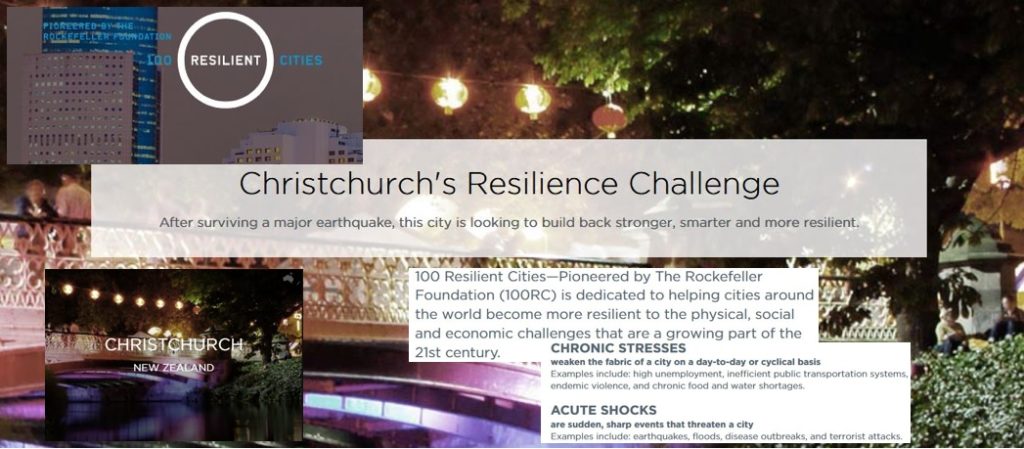
Meanwhile, three Otago University public health researchers undertook a New Zealand Index of Deprivation Index based on 2013 statistics – it’s short title is NZDep2013 – and found Christchurch’s wealthiest suburbs had grown by nearly 13,000 people, while it was claimed that the population of the poorest suburbs had declined by approximately 13,000 people.[57] Otago University co-author, Dr. Peter Crampton, was coy about why roughly 13,000 wealthy people had moved in while 13,000 poor had moved out, and simply stated the wealthy have access to responses that poor families are bereft of when natural disasters occur – international research showed – evidently.

Curiously, Fairfax’s Christchurch newspaper, The Press, omitted mentioning that Dr Crampton was a member of the far-right think-tank, The New Zealand Initiative, whose former incarnation, The New Zealand Business Round-Table, had to change its name because its membership were infamously known as a ‘Who’s Who of Corporate Raiders’ whom took over New Zealand in the mid-1980s to the mid-1990s in accordance with the ‘1980s Project’ Shock Doctrine economic warfare framework – as The Snoopman showed in his exposé essay, Discretionary Idleness: Structural Unemployment as an Economic Warfare Tool in Neo-Colonial New Zealand.[58]
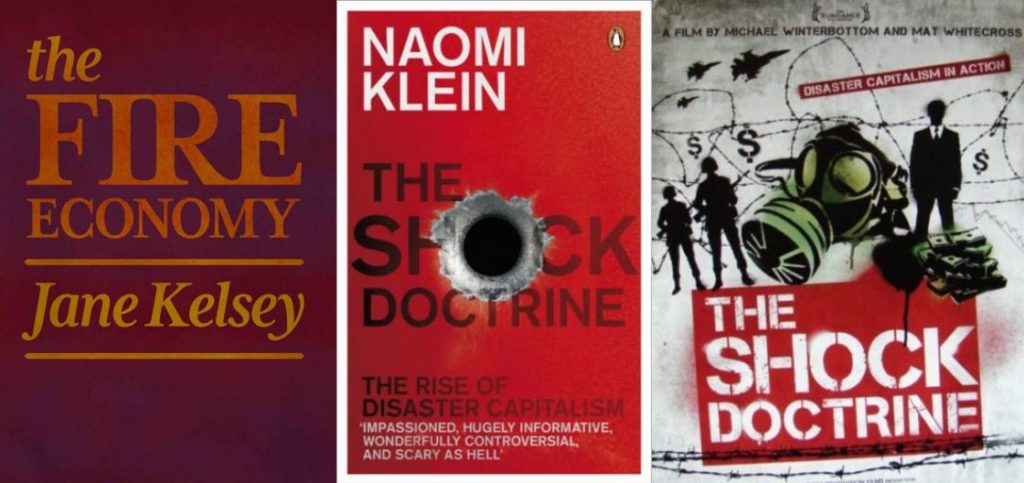
Key Finding: Christchurch’s inclusion in the Rockefeller Foundation’s 100 Resilient Cities Project was consistent with cartel game theory. Key players exploited the skills, talents and ideas of the earnest decent people of Christchurch.
Aurecon: A Special Case of Cartel Collusion?
Snapshot: The symbolism encoded in then-Prime Minister John Key’s pre-election tea-date – in a café on the ground floor of global engineering firm Aurecon – gazetted the rebuild bonanza.
Fascinatingly, global engineering firm, Aurecon, “leveraged [its] strong relationship” with the Grand Central NZ owner of the Hotel Grand Chancellor, which was located on a “key site”, but was badly damaged by the 22.02.2011 earthquake. Aurecon designed the new $85 Grand Central Building for four government departments and ministries, whom drew flak for approving a $13 million fit-out. The Grant Central was built as part of a Christchurch Integrated Government Accommodation Project, which aimed to return 13 government departments and agencies back into “the heart of [the] Christchurch CBD.”[59]

Aurecon – which also had 13 of its staff on the Christchurch City Council’s post-earthquake Mayoral Flood Taskforce and was advisory consultant on a project to build 13 major cycle-ways – was also involved in the Christchurch Bus Interchange, the Deans Head Remediation Project at Christchurch’s Port Hills, and a telecom building deconstruction project at 91 Heresford Street.
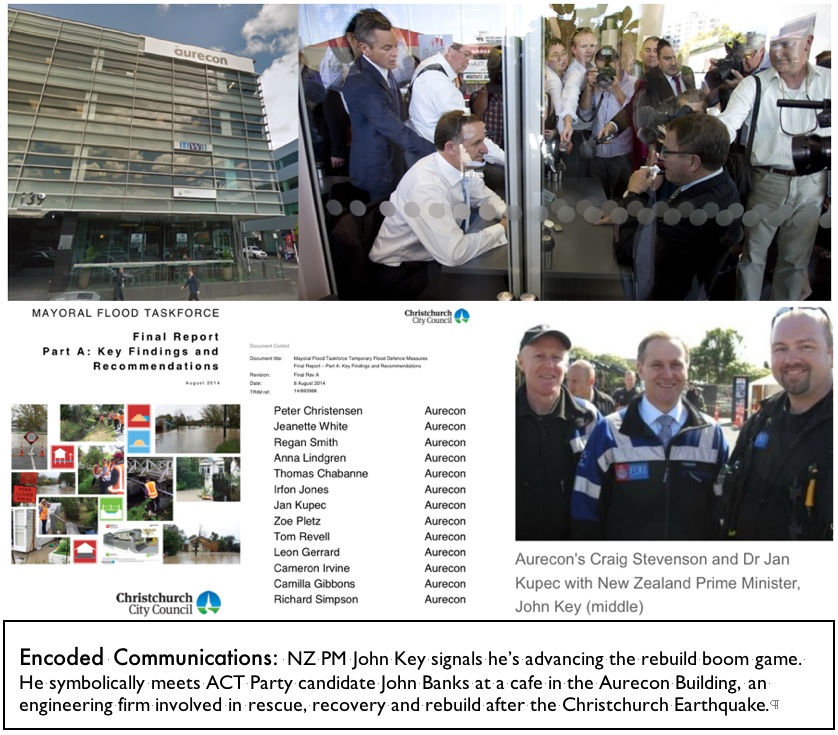
The New Zealand Headquarters of Aurecon is located at 139 Carlton Gore Road, Newmarket, Auckland, a four-storeyed building that Aurecon holds the naming rights to. Applying numerology to 139 Carlton Gore Road Newmarket, 1+3+9 adds up to 13. Given the Aurecon building is four storeys high, the building symbolises a full deck of cards, since 4 multiplied by 13 equals 52. In the Tarot universe, the number 13 is assigned to the Death Card, which does not necessary equate with mortality, nor necessarily death by scythe. It can also denote a ‘rebuild’ after a destruction, or collapse.
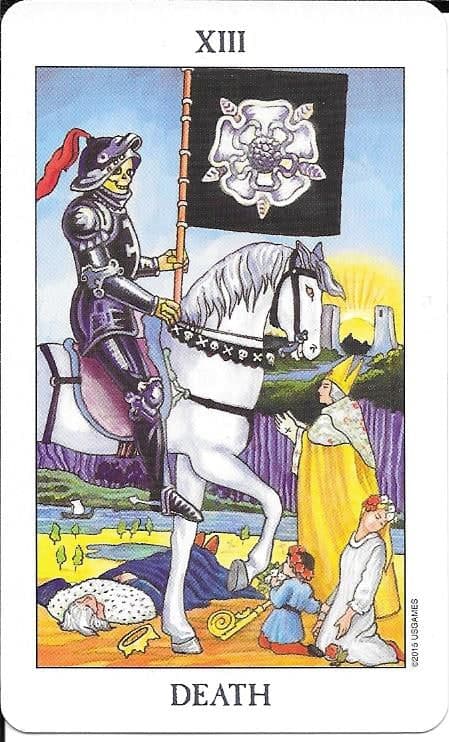
It is, therefore, intriguing to recall a pre-election ‘cup of tea’ meet-up that occurred on 11 November 2011 between then-Prime Minister, John Key, with then-ACT Party Epsom candidate, John Banks, that took place at Urban Café in the Aurecon building in Newmarket. Because Aurecon was involved in the search, rescue and recovery, the symbolic communication signified that not only was Aurecon ‘in the camp’ for the rebuild projects of Christchurch City. By posting himself as a hostage, Key was also communicating both a promise that his incumbent National Coalition Government would deliver on the rebuild blueprints – and a threat – that any alternative would de-stabilize a disaster zone and the economy.
Even more intriguing, in the 3News report of this ‘Teapot Tape’ event – as it soon became known when it blew into scandal – then-political editor Duncan Garner made a point of saying that the meet-up lasted for exactly 13 minutes.[60] Moreover, Garner enthused that the prime minister’s ‘sound-bite’ answer to 3News was precisely 13 seconds long. This was a curious observation that went unexplained. The event signaled Key & Associates’ appreciation for occult symbolism. At its top layer, this deep political event – in part – extended to a play on the Freemason Brother John Banks’ Christian beliefs. In this meeting of the ‘two Johns’, Key was satirically endorsing Banks with the awareness he is a Brethren of Freemasonry, a once-Secret Order whose roots extend beyond the cathedral and castle builders of Europe, back to the stonemason temple builders of antiquity. After all, Christchurch was in serious need of architects, engineers and tradesman skilled in their respective crafts – like the stonemason orders of Medieval Europe and the classical architecture of Antiquity.
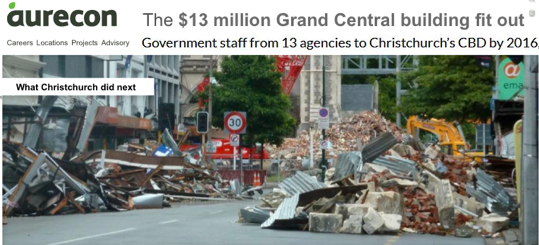
It would appear, then, that Garner was communicating he could see the number 13 had occult significance for the ‘Old Boys’ Network’. Garner described the Johns’ tea event as “a government bailout” for the poorly polling ACT Party. Yet, Garner’s connection with National’s political élite, including Key and National’s opinion polling manager, David Farrar, was well known to the news media – but went unexamined when the meet-up spilled over into the Tea-Pot Tape Scandal for which he and his soon-to-be protégé, Patrick Gower, won the Best Journalism prize at the 2012 Qantas Media Awards – as Snoopman explored in the exposé, “Play Punch Journalism.”[61] Garner’s repetition of the recidivist numerical character actor – ‘Thirteen’ – belied hidden meanings, telegraphed cronyism and signaled the perennial caution of the Old Boys Network: Don’t Dig Deep.
On the ground-floor surface, where savvy, fishy journalists like 3News’s Duncan Garner and then-New Zealand Herald’s Patrick Gower fed – Key was signaling to National Party voters in the Epsom electorate to give their political candidate vote to Bro. Banks. The idea was to boost support for the ACT Party, whose party would not otherwise get enough party votes to reach the 5% mixed member proportional (MMP) voting system threshold.
However, N.Z.’s Establishment Media appeared to neglect to check the Christian Liturgical Calendar. This cup of ‘English Breakfast’ tea event was an exquisite allegorical rework of the St Martin’s story as signaled by the curious date of the cuppa meet-up – 11 November 2011, or 11-11-11. This date is the feast day of St Martin, a Roman soldier who served in the Calvary in Gaul, and – according to miracle legend – he cut his cloak in two to give one-half to a rag-clad beggar in the depths of a chilly winter, and later became known as the ‘Bishop of Tours’. The Calvary Soldier’s reputation was doubtless enhanced when a flattering story spread about him dreaming that very night that none other than Jesus Christ himself was clad in the cloak-half he gave away. Christ spoke with banal punctuated phrasing, like one might expect of a Byzantine bureaucrat, when he evidently said: “Martin, who is still but a catechumen, clothed me with this robe.” Since a catechumen is an apprentice in Christian mythological metaphors, the election touring on 11.11.11, in effect, cast Key as an apprentice in the ‘state-craft’ of codified communications. Thus, Christ appeared to be matter-of-factly humbled to receive recycled clothing after a soldier of the Roman Empire gave it to a poor man in the street. But, oddly, the legendary Messiah character failed to be troubled by the hidden mechanisms of this ‘trickle up charity’ and the motives of the cast of characters in the legend. Key & Associates were riffing off Christian mythology to telegraph the former London and Wall Street banker was the bankable politician for rebuilding the Christian named city of Christchurch. Therefore, St Martin’s sainthood – like many a knighthood, including John Key’s Knight Grand Companion of the New Zealand Order of Merit as well as his Honorary Doctorate of Commerce awarded by Canterbury University – was based on fraud and an applied Shock Doctrine economic warfare.

Notwithstanding this inverted virtue signaling, the ‘coincidence’ of 11 November 2011 being St Martin’s Feast day is fascinating when it is recalled that both Johns have made much of their upbringing in poverty. What better way to signal that the strong can help the weak and the poor can reach high office, than through a beatific political meeting with Key cast as ‘St Martin, the Bishop of Tours’, who was lured to minister a political candidate of a sick political party in need of being nursed back to health?
Poignantly, John Key was photographed with Aurecon staff during the ‘recovery phase’ of the Christchurch after-shocks. The top level in this narrative, communicated that the two politicians embodied the ‘labour hiring fair’ element of the St Martin’s Feast Day, which is celebrated across Europe and traditionally marks the preparation for winter. Therefore, the telegraphing of a labour hiring fair, for the New Zealand Tax Farm – ‘the NZ INC. economy’ – which was at the time critical for the intended Christchurch City rebuild, amid earthquake shakes. This ‘labour hiring fair’ subsequently manifested as the Fletcher Building Careers Fair held on 9 June 2012, between 10am and 3pm, or 10-3, an event that reportedly signed up 13,000 construction industry contractors. Thus, when Key stated to the news media that the country would get a “stable government”, he was mockingly signaling that it was only through his government and the Christian Freemason ACT Party candidate for the Epsom seat, that a corporate alliance could exploit the rebuild bonanza in a shaken city with a very Christian name. Therefore, this ‘fourth level’ narrative cast John Key as the ‘Bishop of Tours’ for the Christchurch rebuild and other construction projects, as the event’s location at the Aurecon engineering and construction firm’s New Zealand HQ symbolized. Key & Associates’ were riffing off hidden, or occult, symbolism as self-referential expressions of their control over events, to accumulate political power, to create copies of reality and advance the game of collusion.[62]
Key Finding: 3News‘ Duncan Garner read the ‘tea leaves’ of the Aurecon building’s address, and failed to disclose his connection to National Party key insiders whom were well-placed to read the meta-message – the PM would stabilize the shaky economy with the help of the Old Boys’ Network.

Analysis: ‘Finger Prints’ of the Brotherhood’s Hand
Snapshot: The symbolism embedded in the Christchurch Rebuild Bonanza signaled the Brotherhoods’ hand – to those attuned to the codified communications of cartel game theory.
The recurrence of the recidivist number 13 in the Christchurch Rebuild metadata reveals a game of cartel collusion. The arbitrary deployment of the serially re-offending numerical figure – ‘Thirteen’ – and its variants and multiples worked as ‘accomplices’ to assist members of the Patriarchal Brotherhoods – foreign and domestic – to locate one another in various institutions. The metadata was loaded to signify unity among a hidden fraternal network of men (mostly).
Crucially, because the rebuild metadata also worked as a covert mechanism to communicate caution, it meant that when the inevitable scandals did break over arbitrary, unfair, and ultimately fraudulent decisions – the ensuing investigations were, quite predictably, tightly controlled so that they did not escalate into a full-blown crisis. To attuned eyes, Thirteen and its Accomplices acted like a cast of criminal culprits whose presence were not to be betrayed – lest all hell broke loose. Because Thirteen and its Accomplices were self-referential codes for the Christchurch Construction Cartel’s game of collusion, any code-breaking exposure by members of the Brotherhood would have swiftly resulted in defections in the ensuing moves. Therefore, by these means, the scandals concerning mass demolitions, rezoning and confiscations of private property, as well as insurance claims, shoddy repairs instead of proper rebuild resource allocations, and stealthily forgoing the opportunity to build off-grid water, power and sewerage systems – were smothered by a thousand acts of systemic corruption, collusion and conspiracy.
What journalists at Christchurch newspaper, The Press, University of Otago politics lecturer Bryce Edwards and the late-conservative liberal politician Jim Anderton – could not see was just how deftly the Brotherhood signaled their unfolding moves with Thirteen and its Accomplices to exploit the earthquake crisis. Even The Christchurch Fiasco and the Insurance Aftershock blogger, Sarah-Alice Miles, missed the deployment of this prime number and its accomplices in her extensive, excellent chronicles about the corporatism practiced between government and big business that dominated Christchurch’s ‘recovery’ and the malfeasance of insurance companies and the subsequent substandard rebates, repairs and rebuilds for the commoners of Canterbury and Christchurch.[63] Indeed, one respondent in a survey conducted for the Red Cross stated that without the Red Cross Independent Advice Grant of $500, many would not have been able to pay an engineer to contest a standard insurance payout of $13,000 to repair or rebuild homes.[64] Due to this knowledge gap about the Brotherhood’s favourite cartel collusion prime number, the numerical symbol ‘Thirteen’ in this $13,000 standard insurance payout slinked by stealthily in the Red Cross report like a Wall Street wolf in Manhattan Island sheep’s clothing among the Christchurch Rebuild meta-data – instead of being regarded as an artifact of the primary suspects: the Christchurch Construction Cartel.
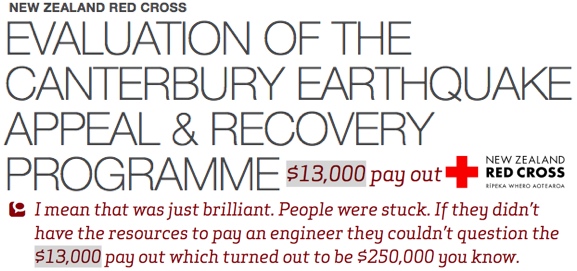
Even, the Commerce Commission – whom are supposed to be the experts for catching cartel collusion – missed the criminal activities of ‘Thirteen’ and its ‘Accomplices’. On its ‘Make a Complaint’ page, the Commerce Commission says it’s hard to detect cartel collusion.[65] Perhaps this is because they haven’t read groundbreaking books such as Naomi Klein’s, The Shock Doctrine: The Rise of Disaster Capitalism, or Jeffrey Winters’, Oligarchy, or Giants: The Global Power Elite by Professor Peter Phillips, or the book, Capital as Power, by Johnathan Nitzan and Shimshon Bichler.
Like so many heads of public and private institutions of major and significant states, the top brass of New Zealand’s Commerce Commission do not draw upon the knowledge held by the underlings – whom would jump at the chance to model robustly for cartel collusion. As Neal Katyal stated in his 2002 paper “Conspiracy theory” published in The Yale Law Journal, a “sunk cost trap” dynamic is created when people commit to a specific course of action that binds them and escalates previous behaviour.66] Consequently, a conspiring administration’s players, or a private colluding confederacy, will take corrective action to serve their secret goals. When sub-terrain ructions occur or scandals break, evidence of enjoinable conduct will predictably surface in the unfolding events as ‘messy aftermath’ event clusters.67]
As such, even when someone like then-chief executive of Canterbury Employers’ Chamber of Commerce, Peter Townsend, remarked that “there’s a lot of money sloshing around” and “the old guard have done very well” – the Commerce Commission failed to tease out of the Chamber of Commerce’s Townsend whom exactly comprised the ‘old guard’.

And how exactly was a figure of $13 billion allocated for a rebuild of commercial buildings – many for the CBD? Likewise, when Boffa Miskell landscape architect CEO, Don Miskell, enthused about the 100 Days Blueprint Project in The Press – the Commerce Commission failed to recognize the reproduction of the key Brotherhood number for collusion – Thirteen. After all – The Press reported that sticking the police and courts next to the new central bus terminal would concentrate 1300 workers in an under-populated part of the city to make life easier for their ‘customers’[68]. Was it because Mr Miskell neglected to mention that there were 13 Anchor Projects? Or was it because the editors of The Press neglected to mention to reporter Mike McCrone that it was significant that the Anchor Projects tallied up to Thirteen? Did The Press editor-in-chief suppress the truth – when McCrone gazetted the obvious cronyism in “The business of NZ Inc” – lest it gave away the criminal collusion? How does a daily city newspaper miss such rampant self-referential, arbitrary signalling? And Does the Commerce Commission not monitor for cartels if they are supervised by Ministers of the Crown – lest the true nature, composition and pecuniary interests of ‘the Crown’ are laid bare.
Although the Brotherhood that colluded to ‘make life easier’ for the public transport-using ‘customers’ of the newly-created justice precinct in Christchurch did not intend that they would become ‘customers’ too, their fingerprints in the meta-data suggests their hubris will be their downfall.
Especially, if the women who work for New Zealand’s Neo-Colonial Patriarchy – or whom suffer in their shadow and the shade of their Fraternal Foreign Friends – dig further in places like club members’ lists, personal assistant diaries, and private ‘trust’ accounts. After all, the existence of a cartel such as the Christchurch Construction Cartel, meant that those who weren’t in the Brotherhood’s ‘camp’ – including smaller players, new market entrants, women and indigenous Māori – were either excluded, undermined or exploited. Moreover, given that the construction industry tallied up first place among New Zealand’s industries for suicides for the decade from 2007 to 2017, it is clear that the country’s construction industry – which is also dominated by a cartel – has a huge problem; need I say? It is not the case that New Zealand’s construction industry is alone in being cartelized, because every industry is dominated by a cartel.
Indeed, the presence of cartels that are owned, controlled and directed by interlaced interests to form vast monopolies are a key feature of Ne-Colonialism – as the former President of Ghana, Kwame Nkrumah, showed in his 1965 book, Neo-Colonialism: The Last Stage of Imperialism. In his study of the African continent, Nkrumah found that though a Neo-Colonial state had the outward appearance of international sovereignty, the political apparatus took external directions because its economic resources and financial systems were controlled from the outside. Nkrumah’s findings some 58 years ago shine valuable light on the Christchurch Construction Cartel – particularly given that Christchurch was absorbed into the first 33 cities of the Rockefeller Foundation’s 100 Resilient Cities Project. And, the fact that the N.Z. Government does not exercise the sovereign power to run a debt-free positive money system. Likewise, that tens of billions flowed into Christchurch from international insurance consortia, investment groups and banks. Because cartels are the product of dominant coalitions of capitalists, whose control over economic resources becomes so concentrated, they are able to steer the political trajectories of whole societies. Such capitalist coalitions of super-rich families and individuals comprise an oligarchy – a manifestation that can only occur in societies of great economic inequality. Indeed, oligarchs actually thrive in crisis-ridden societies and if their cartels are left unchecked, they fuse with the state apparatus to form or join expansionist empires to sustain growth for their excessive wealth. Therefore, it is in the interests of an oligarchy to exploit, control and even engineer crises, in order to gain economically and politically amid a state of shock – as Klein’s Shock Doctrine thesis predicts.
What would happen if the construction industry’s suicide data-set – that was supplied by the New Zealand Government’s Coronial Services to the Building Research Association of New Zealand (Branz) – were applied as a control data-set? If we test the supposition that the Christchurch rebuild data-set is riddled with the number 13 because it belies the cartel hand of the Old Boys’ Network – this recidivist prime number could be expected to be embedded in the data-set supplied by Suicide in New Zealand’s Construction Industry Workforce to signal caution. Indeed, the character Thirteen is practically flaunted upfront – for those with eyes attuned to this weird, spooky and pervasive occult ‘morse code’.
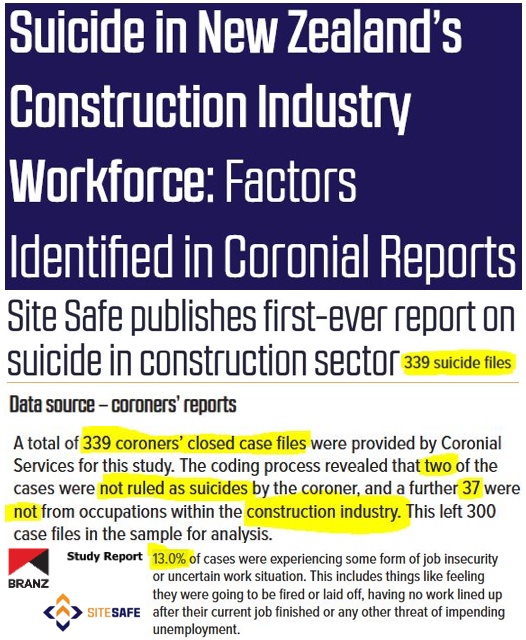
Coronial Services provided a data-set of 339 Coroners’ reports on construction industry suicides, which rendered down to 13 by dividing 39 by 3. Conspicuously, the researchers of the subsequent BRANZ Study Report – “Suicide in New Zealand’s Construction Industry Workforce: Factors Identified in Coronial Reports” – found that 39 of this data-set had to be excluded because 37 deceased individuals were not working in the construction industry and two deaths were ruled not to be suicides. This means that Coronial Services included 39 cases that even a dunce could see would fail to meet the criteria. This curious mis-selection is the ‘tell’, or give-away sign, that the Brotherhood’s ‘hand’ was involved in the mis-selection of the extra 39 – which renders down to 13 by the division of 39 by 3. Predictably, the figure of 339 was widely misreported as the number of construction industry suicides for the decade to 2017. The intention behind this mis-selection was to telegraph caution to the ‘Old Boys Network’ about how the investigation is framed, reported and followed-up. Its easy to see why because the researchers reported that 27 cases contained no information around the circumstances of death, and some were devoid of data on the place of death and the age of the deceased. The biggest category of work-related factors was ‘job insecurity or uncertain work situation’ in 13% of cases. Did some coroners avoid reporting the circumstances surrounding the suicides so that the construction industry’s biggest work-related suicide factors’ category would yield 13% – as a sick boast and hat-tip to the psychopaths whom inflicted Shock Therapies on the New Zealand economy? Or was the study commissioned at a time when the ‘statistical killers’ had achieved a suicide rate with 13% of cases attributed to the ‘job insecurity or uncertain work situation’ factor?
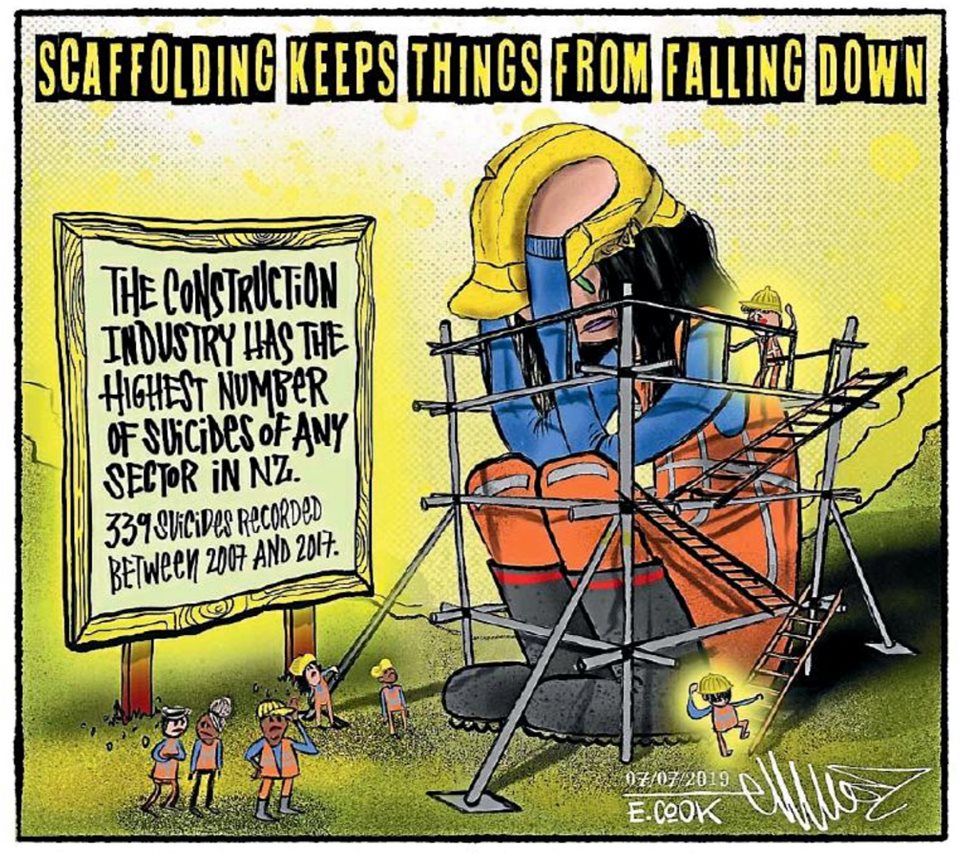
After-all, the Australian Citizens Electoral Council showed the correlation between the rise of suicides and the corporate takeover of New Zealand in their 1996 report, “Nazi ‘Reforms’ Rip New Zealand—Australia Next”. This figure is significant because one of key elements of the Shock Doctrine economic warfare framework was to inflict unstable employment. In such an environment, workers wage and salary bargaining power is diminished, a situation that suits big business cartels whom collude to wrest extortionist profits from economies – as The Snoopman showed in “Structural Unemployment as an Economic Warfare Tool in Neo-Colonial New Zealand”. Moreover, the cartelization of an industry located in a cartelized economy creates huge stresses. The root cause of these stresses is the Neo-Colonial Patriarchy.
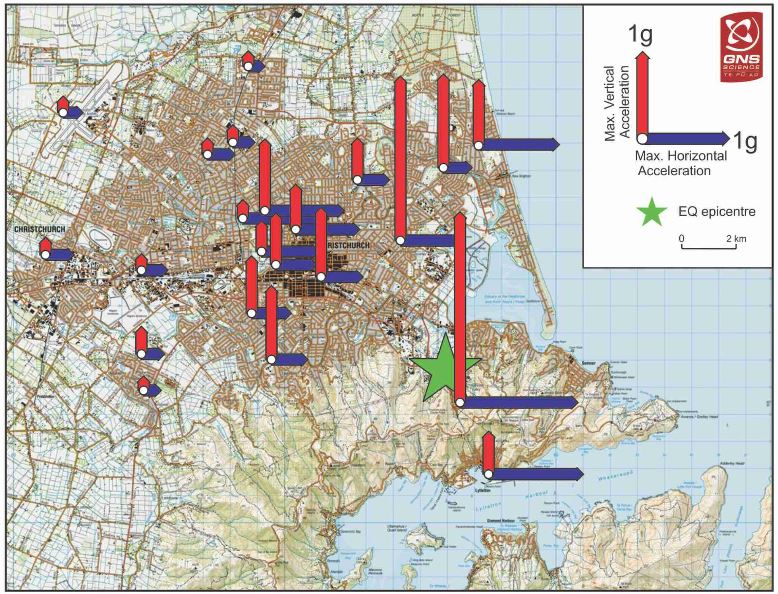
The appearances of the number 13, its multiples and variants in the institutional meta-data of the Christchurch rebuild bonanza does not necessarily mean that the nominal head of the institution is a member of the Fraternity, or that everyone who reproduces such data belongs to the Brotherhood. It could be argued that these numbers are cherry-picked. There is much meta-data that doesn’t carry the prime number 13, its multiple or its variants. However, much of the key figures were embedded with 13, and where it appeared in government, corporate or news reports, the recidivist prime number – or its variants – this meta-data often masqueraded as innocent ‘bystanders’ instead of as conscious culprits, accomplices and prime suspects.
Moreover, the Brotherhood will often rework their original quantum quotas that star the number Thirteen and its Accomplices with ‘sequel roles’. Like Hollywood actors, the ‘sequels cast’ were signed with brazenly bigger numbers, the pre-publicity gazetted budget overruns, and the premiere openings hid the underlying expansion of the cartel’s franchise. In this way, the Christchurch City Council’s excitement about 13 new major cycle ways turned into a predictable laying down of the law when the cost predictably ballooned to $252 million – as The Press reporter Tina Law gazetted. The Christchurch City Council’s new position appeared to riff off British Prime Minister Margaret Thatcher’s ‘free market reforms’ edict – ‘There Is No Alternative’, or TINA, and could be rightly called a TINA Law Ritual. (Was The Press acting-editor Kamala Hayman sharing an in-joke with the Old Boys’ Network? Because Hayman claimed on being appointed as editor that the newsroom is committed to “holding those in power to account” – after her predecessor Joanna Norris took up the chief executive post at ChristchurchNZ, alongside Mayor Lianne Dalziel). The ballooned budget for 13 cycle ways of $252 million was an exquisitely cute capstone figure that topped the estimate figure. By applying numerology, the budget blowout of $252 million rendered down to 13 by dividing the full deck of cards number – 52 – in 2 to yield 26, and by slicing this Cycling Cake into two Crony halves, two prime cuts of the meaty number Thirteen were harvested.[50]
Once projects served their purpose of signaling solidarity by institutional players’ posting themselves as hostages to advance the game of collusion, the prime number 13 often dropped off the meta-data. This ‘drop-off’ was not a sign of defections, but rather was indicative of the Brotherhood getting on the business of project completion with the real numbers. The deployment of Thirteen and its Accomplices acted as a carrier for the Brotherhood’s codified communications that were embedded with threats and promises, and signposted where colluding members of the Old Boy’s Network could be found. In other words, some of the published project meta-data were interim quanta deployed for the purposes of posting hostages to stabilize the shifting power relations amid a crisis.
To coincidence theorists who are still skeptical, how can so much key data be a carrier for ‘13’ and still be mere coincidence? In the worldview of alchemy, astrology and metaphysics, the universe is serendipitous – meaning synchronicity is frequent. That said, what are the odds that the Christchurch Earthquake could inflict destruction with such precision that Christchurch City required exactly 13,000 new homes at a given point in time? What are the odds that Fletcher Building estimated a $13 billion bill to repair houses,[70] reported 13,000 home repairs completed[71] and claimed 13000 more dwellings needed repair? What are the odds that Fletcher Building would also ‘induct’ 13,000 contractors for the Christchurch rebuild, thereby doubling the number of construction industry workers to 26,000? What are the chances that the Christchurch Earthquake’s destruction was so perfect that it resulted in Christchurch businesses gaining consents for 1.3 million square metres of business floor space at a particular point in time? How is that the Canterbury Earthquakes and Aftershocks could be so perfectly destructive that engineering and construction firm, The Gough Group, was able to brag that Christchurch City and the Canterbury Region required over 1300 kilometres of water pipes, 13 kilometres of stop-banks, 13 new bridges, and even a 130km irrigation project? What are the odds that the Christchurch Earthquake’s destructive forces were so precise that it would lead Fletcher Construction to boast 1.3 million square metres of roads had been constructed, despite Fulton Hogan reporting that road-laying taking up to 13 snail-pace weeks per kilometre?

How did the Canterbury Earthquakes and Aftershocks command such omniscient power that the destruction induced the EarthQuake Commission to pay out $1.3 billion in the first six months, and stump-up $13 billion to rebuild Christchurch’s commercial structures by August 2016? Likewise, how did the earth move AMI to double down on its insurance cover of $1.3 billion, and also shake the Medical Assurance Society to write off 13 commercial properties?
Perhaps more puzzling, how did the Christchurch Earthquake gain such precision in its destructive forces that it induced then-Education Minister Hekia Parata to propose – on September 13th 2012 – closing exactly 13 schools and resolve to merge them into one mega-school comprising Year 1-13 students? That the destructive might of the earthquake appears to have wielded such precise ‘creative’ energies to influence the Education Ministry to publicly suggest a public-private partnership charter schools initiative, with exquisite timing even down to the day of a month – the 13th – is simultaneously unexpected, weird and astonishingly spooky.
Even spookier, how did the Christchurch Earthquake shove out approximately 13,000 poor people, and draw in 13,000 people to the wealthiest suburbs during the rebuild bonanza? And, how was it that the Christchurch Earthquake could be so precise that it cost the economy 13% of its Gross Domestic Product (GDP), a figure that was neatly compensated by Canterbury’s Gross Regional Product (GRP) of 13% of New Zealand’s total?

You would think that the Education Minister might have taken an interest in funding a study to determine whether the Canterbury Earthquake and Aftershocks had wielded such precise destructive forces and creative energies, or whether it was just coincidence that would one day be cherry-picked by a fringe lunatic moon-bat wearing tinfoil hatter. Particularly when GeoNet announced there had been 13,000 earthquakes and aftershocks, a fact that took on a life of its own when the figure was reported in multiple government, corporate and news reports – and quoted by the minister charged with overseeing the Christchurch Construction Cartel: Gerry Brownlee.
Furthermore, by what mechanisms did the Christchurch Earthquake and subsequent floods collaborate to ensure that global engineering firm, Aurecon, had 13 of its staff on the Christchurch City Council’s post-earthquake Mayoral Flood Taskforce? Were these similar mechanisms by which four government departments and ministries approved a $13 million furbishing of the Grand Central Building, which was designed by Aurecon, as part of an integrated building complex to house 13 state ministries and agencies?
Further research, as well as whistle-blowing, subpoenas and prosecutions are required to determine by what transmission mechanisms can an earthquake and the aftershocks wield both destructive forces as well as release creative energies – with such exacting precision. Such groundbreaking research, investigations and criminal proceedings may yield earth-shattering results. Robust scientific investigative parameters imply a control to test the data. It is ‘fortunate’, given the dark circumstances, that New Zealand is the planet’s premiere test lab to experiment with new technologies, social engineering pilot studies and political stratagems.[72] Its isolated location atop the submerged continent of Zealandia,[73] means this South Pacific archipelago can be neatly cast as both a test subject and the experiment’s control.
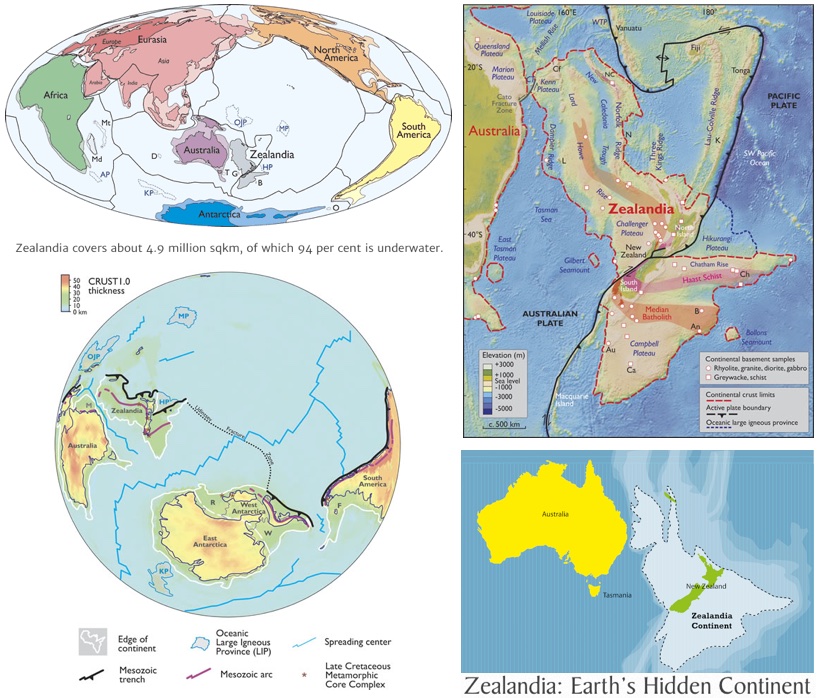
Moreover, because the Victoria University of Wellington had conducted earthquake experiments, called the SAHKE Seismic Experiment, between 2009 and 2011[74] – New Zealand has the academic experience to simultaneously model for the possible hidden transmission mechanisms of social control via earthquakes and tremors.
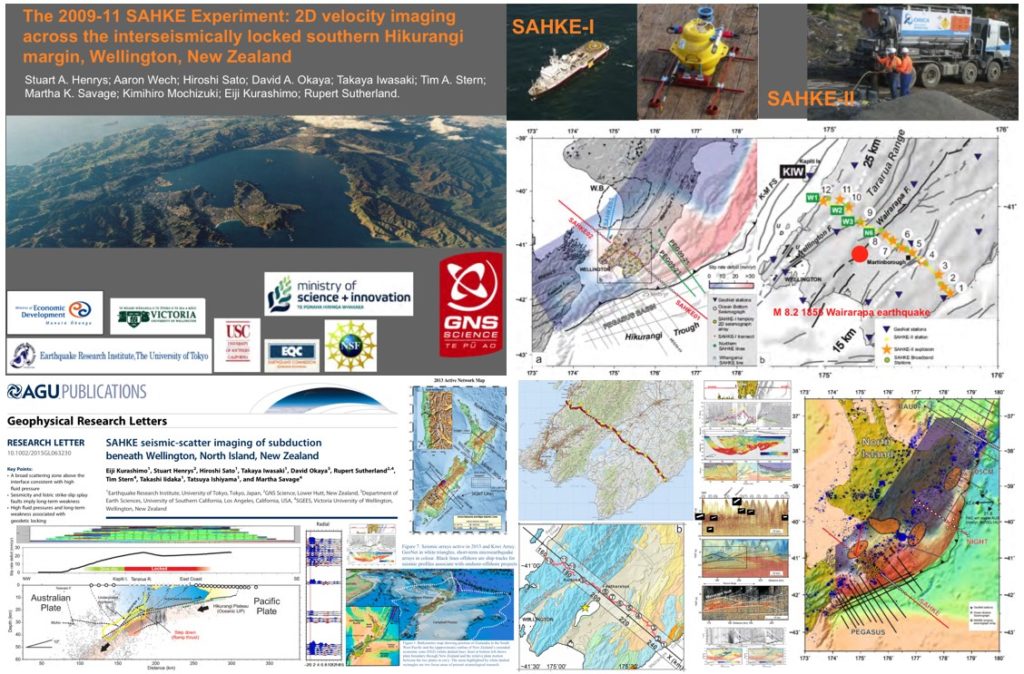
It follows that such groundbreaking research requires robust research questions with in-built skepticism. Perhaps the key research question would test to find out how exactly earthquakes wield both destructive forces and creative energies with such precision to induce institutions across an economy to obey Nature’s occult call sign: Thirteen.
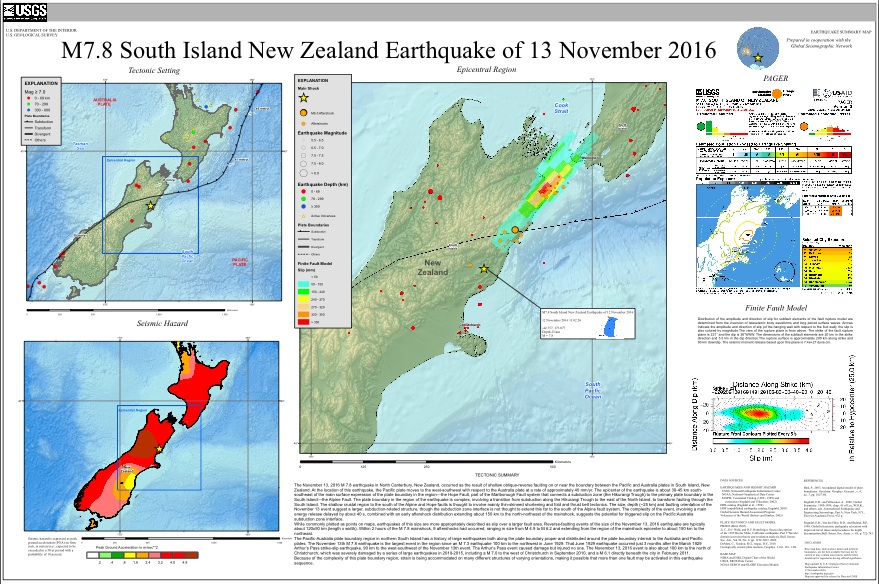
More specifically skeptical: were the Canterbury Earthquakes the work of the Māori god of earthquakes, volcanoes and seasons – Rūaumoko? And did Rūaumoko possess the Brotherhood’s Hand to announce that the tectonic plates had clocked up 13,000 earthquakes?[73] And if so, was the Māori Mother Earth god, Papatūānuku, also to blame for practising contrived ignorance while her son, Rūaumoko, possessed the Brotherhood’s Hand at GeoNet, when this entity of the NZ EarthQuake Commission announced that the tectonic plates had clocked up another 13,000 earthquakes in aftermath of the Kaikōura Earthquake of 14 November at 12:02am (or 11:02, November 13th, UTC)?[74] And when insurance conglomerate, Lloyd’s, reported in its 2018 City Risk Index that New Zealand had clocked up 13 natural disasters, which have cost insurers more than $60 million ‘in today’s terms’ – was Lloyd’s covering-up systemic collusion with the New Zealand Brotherhood in the way the insurance industry handles reimbursements, records losses and recovers from disasters?[75] Or, did Papatūānuku cast a spell over insurance conglomerate, Lloyd’s of London, to self-referentially boast that the Māori Mother Earth God and her son, Rūaumoko, have a covert criminal history?
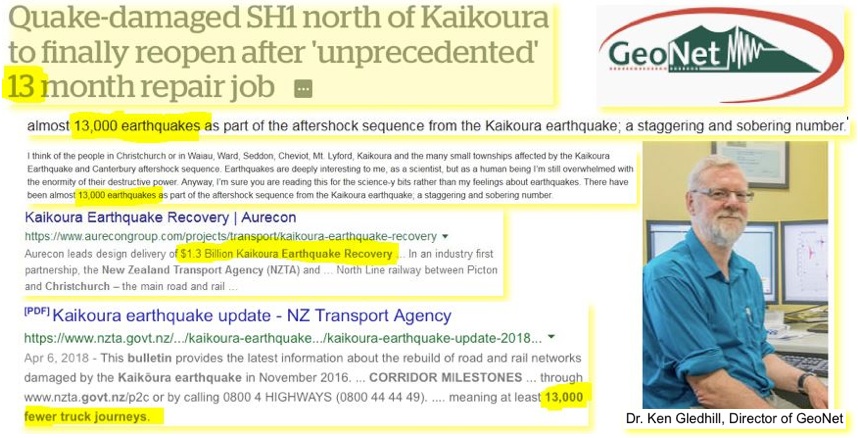
To be superclear, I am not saying that Ngāi Tahu iwi or its tribal council, Te Rūnanga o Ngāi Tahu, were complicit in any collusion. This study shows that the cartel collusion of the Pākehā Patriarchy – more commonly referred to as the Old Boys’ Network – was extensive during the Christchurch Rebuild. Nearly all who were un-attuned to the occult deployment of the number 13, and most would have missed the phenomena. Yet, nearly everyone has been scraped by it – or worse.
The cohesion of élite players was reflected in the proliferation of rebuild entities, the comprehensive penetration into processes and the control of meta-data production in phenomena associated with insurance payouts, the quanta used in rebuild projects, and other resources allocations. Even unrelated event clusters ontained codified information. In the reports on the construction industry suicides, the inclusion of the 39 suicide cases that would not meet the study criteria – thereby codified caution since the offering of 339 cases as a sample signalled 39 could be divided by 3 to yield the occult Brotherhood number – 13. This caution was signalled as an encoded threat that the study, and its subsequent reporting and other public discourses needed to be tightly framed so that the Neo-Colonial Oligarchy remained off-limits to scrutiny, since such super-rich people cannot exist in societies where great economic disparities, crisis exploitation and cartel collusion are not tolerated. Spookily, the meta-data associated with the Kaikōura Earthquake demonstrated the Neo-Colonial patriarchy was still at-large with its primary modus operandi for telegraphing collusion: the morse code-esque deployment of Thirteen.
Key Finding: The Christchurch Construction Cartel exploited speed, suddenness and scope to overwhelm, wear down and outrun opposition. The true nature of the key perpetrators’s occult hostage-posting rituals remained obscure to the good people of Christchurch, Canterbury and the rest of New Zealand.
Curiouser and Curiouser: Summary of Key Meta-data
This case study – Codified Collusion by Christchurch Construction Cartel – smashes the default position, or null hypothesis, of coincidence theorists whom would hold that the arbitrary appearances of the number 13 in the Christchurch rebuild metadata is mere chance.
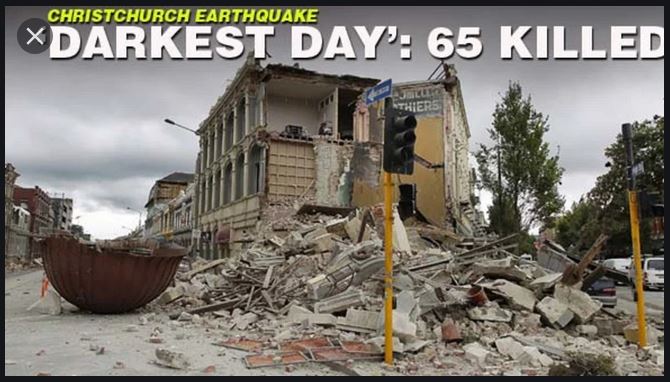
Key meta-data in the Christchurch and Canterbury Rebuild was encoded with the Thirteen, its multiples and variants to telegraph collusion, caution and cover-up. Such key data, which was sometimes provisional, included:
(1) 13 key Anchor Projects for Ōtākaro Limited’s 13 Precincts in the Christchurch Central Business District;
(2) the Canterbury Earthquake Recovery Authority (CERA) signalling 1300 commercial buildings might be demolished; and issuing a notice that 13,000 commercial and industrial buildings in the greater Christchurch area would be surveyed;
(3) EarthQuake Commission paying out $13 billion for commercial construction;
(4) Fletcher Building estimated a $13 billion bill to repair houses;
(4) 13,000 homes deemed to need repair and subsequently were repaired, and 13,000 new homes were required and 13,000 residential building consents were issued;
(5) 13,000 contractors were inducted, which doubled the construction industry workforce to 26,000;
(6) the EarthQuake Commission paying out $1.3bn in the first six months following the M6.3 Christchurch Aftershock, and AMI doubling down on its insurance cover of $1.3 billion;
(7) 1.3 million square metres of roads that took up to 13 weeks per kilometre to lay;
(8) 1300 kilometres of ultra fast broadband cable reported yet to be laid;
(9) planning 13 major cycleways, followed by a budget blow-out extending the costs to $252million – that rendered down to 13 by dividing this full deck of cards number – 52 – in 2 to yield 26, which is a multiple of 13.
(10) Education Minister Hekia Parata proposing – on September 13th 2012 – the closure and merger of 13 schools into one Year 1-13 mega-school;
(11) the 2013 New Zealand Index of Deprivation Index (NZDep2013) finding the population of Christchurch’s wealthiest suburbs had grown by nearly 13,000, while the poorest suburbs had declined by about 13,000 people;
(12) the Christchurch Integrated Government Accommodation Project including a goal to return 13 government departments and agencies to the CBD – and four state entities approving a $13 million fit-out of the Grand Central building;
(13) 130 projects overseen by CERA during its lifespan, amid the widespread and prolonged regurgitation of GeoNet’s 13,000 Earthquakes figure.
The tally of figures was sometimes provisional, and final data often bigger in many cases than reported, such as there actually being 17 anchor projects – while 13 were deemed key anchor projects. Or the figures subsequently became bigger as the construction cartel got down to business. The point is that the number 13, its multiples and its variants were used to signal solidarity with the Brotherhood, codify caution and derail scandals – lest they escalated into crises.

Key Finding: The stunning recurrences of 13, its multiples and its variants to telegraph cartel collusion in key Christchurch Rebuild meta-data – smashes the coincidence theorist worldview that brainwashes people to ignore their senses and fail to catch this weird prime number red-handed.
Conclusion: Cohesive Christchurch Construction Cartel Collusion
In the aftermath of the Canterbury earthquakes and aftershocks, New Zealand’s Old Boys’ Network took graft to the next level. The Neo-Colonial Patriarchy encoded their communications to signify unity, caution and cues for scape-goating using the prime number 13. The mostly-Pākehā Patriarchy and their Foreign Fraternal Friends used 13, its multiples and variants to locate one another across public and private sector institutions, communicate the advancement of ‘the game’ and buy-in to inflict a Shock Doctrine cartel business model.
The deployment of ‘Thirteen’ and its ‘Accomplices’ advanced the cartel game by staging Brotherhood Bonding Rituals to signal promises and threats, telegraph caution and control the inevitable scandals while exploiting the disaster. The codified communications in government, corporate and media reports – as well as at public and private events – worked as hostage posting mechanisms to stabilize the shifting power structures for those seeking to capitalize on the crisis. If other players were not seen to be posting themselves as ‘hostages’ – defections could be expected on the next moves.
The cohesion of this Pākehā-dominated Patriarchy was robust enough to withstand even well reasoned critiques that tabled examples of cronyism, collusion and corruption. This was due – in no small part – to the fact that the cartel crossed the government and corporate apparatus and was, in effect, a Deep State network operating like a parallel Shadow Government to the visible Public State. Absent a tectonic exposure of the Pākehā-dominated Brotherhood, the recidivist character ‘Thirteen’ and its Accomplices will likely remain at-large, free to continue re-offending.

Key Finding: Amid the tectonic shakes, a meta-message was communicated in the Christchurch Rebuild Bonanza meta-data: Don’t mention the Neo-Colonial Patriarchy and their recidivist occult character – Thirteen.
* Editor’s note: The author added highlights to emphasize 13 in the original publications.
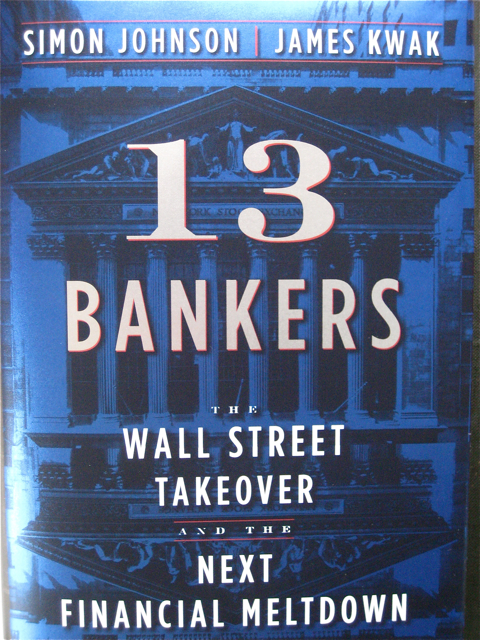
Post-script: The practice of embedding events with the number 13 came to The Snoopman’s attention when he read Simon Johnson and James Kwak’s book, 13 Bankers: The Wall Street Takeover and the Next Financial Meltdown, while researching his thesis on the Global Financial Crisis, entitled It’s the Financial Oligarchy, Stupid. Johnson and Kwak did not explicitly state why exactly élites embed events with this curious prime number, but just noted its curious recurrence. The appearances of the number 13 in institutional data does not necessarily mean that the nominal head of the institution is a member of a Fraternity, or that everyone who reproduces such data belongs to a Brotherhood. It signifies a Brotherhood’s hand.
See the summary version:
[1] John McCrone (9 September 2012). The Business of NZ Inc. The Press. http://www.stuff.co.nz/the-press/news/christchurch-earthquake-2011/7637382/The-business-of-NZ-Inc
[2] John McCrone. (Aug 04 2012). Plan will change the face of Christchurch. http://www.stuff.co.nz/the-press/news/7413466/Plan-will-change-the-face-of-Christchurch; Sarah-Alice Miles, The Insurance Aftershock: the Christchurch Fiasco Post –Earthquake 2010-2016. https://thechristchurchfiasco.wordpress.com/; Sarah Miles. (March 31, 2013). Land Grab In Christchurch. https://thechristchurchfiasco.wordpress.com/tag/hurricane-katrina/; CHRIS HUTCHING. (December 23 2016). New SCIRT-like alliance for Kaikoura rebuild. http://www.stuff.co.nz/business/87859409/New-SCIRT-like-alliance-for-Kaikoura-rebuild; Christchurch business leaders meet to discuss future. NZPA and NBR staff. (March 14, 2011). Christchurch business leaders meet to discuss future Christchurch business leaders meet to discuss future https://www.nbr.co.nz/article/christchurch-business-leaders-meet-discuss-future-nn-88182#comment-71626
[3] Paul Chapman, Bonnie Malkin & Andrew Hough. (22 Feb 2011). Christchurch earthquake: 150 feared dead on New Zealand’s ‘darkest day’. https://www.telegraph.co.uk/news/worldnews/australiaandthepacific/newzealand/8340407/Christchurch-earthquake-150-feared-dead-on-New-Zealands-darkest-day.html
[4] Janet Wilson. (18 April 2011). “Sam the man”. New Zealand Listener. https://www.noted.co.nz/archive/listener-nz-2011/sam-the-man/
[5] CATDAT. (2011). “Damaging Earthquakes Database 2011 – The year in review”, Integrated Historical Global Catastrophic Database.; Chang, S. E., Taylor, J. E., Elwood, K. J., Seville, E., Brunsdon, D., & Gartner, M. (2014). Urban Disaster Recovery in Christchurch: The Central Business District Cordon and Other Critical Decisions, p.2. Earthquake Spectra. doi: 10.1193/022413EQS050M; The median weekly income for the greater Christchurch area in 2013 was $1313 Christchurch Earthquake Recovery Authority. (June 2014). Canterbury Wellbeing Index, p.2
[6] The primary number Thirteen symbolizes ‘unity and fraternal love’, and ‘procuring marriage agreements’, as infamous occultist Aleister Crowley stated in his book, Liber 777, and W. Wynn Westcott asserted in his work, Numbers: Their Occult Power and Mystic Virtues.
[7] Aleister Crowley. (1986). Liber 777, xxv; “An Essay Upon Numbers”. In: Israel Regardie (Ed.). (1994). 777 and Other Qabalistic Writings of Aleister Crowley, p.29. York Beach, Maine; USA: Samuel Wesier Inc.; W. Wynn Westcott. (1911). Numbers: Their Occult Power and Mystic Virtues, p.109.
The complete Press Power List 2013 19:01, Mar 25 2014 http://www.stuff.co.nz/the-press/8613830/The-complete-Press-Power-List-2013; SCIRT memento bookStory: SCIRT Memento Book https://scirtlearninglegacy.org.nz/sites/default/files/qsr-part_338178.pdf
[8] Aston McGill. (19 Dec 2013). Canterbury Earthquakes Epicenter 3D Model https://www.youtube.com/watch?v=4tSc_bHQBec; Christchurch Quake Map. Retrieved from http://www.christchurchquakemap.co.nz/; Canterbury Earthquake Recovery Authority. (October 2015). Minister’s Message, p. 1. Greater Christchurch Earthquake Recovery: Transition to Regeneration Transition Recovery Plan October 2015. Christchurch, New Zealand: CERA.
[9] Li Huizi. (21 Feb 2019). Feature: New Zealand’s Christchurch recovering from devastating earthquake Source: Xinhua| Feature: New Zealand’s Christchurch recovering from devastating earthquake – Xinhua | English.news.cn http://www.xinhuanet.com/english/2019-02/21/c_137839435.htm
[10] Lyn Provost. (31 January 2017). Canterbury Earthquake Recovery Authority: Assessing its effectiveness and efficiency. Controller and Auditor-General’s Report. Retrieved from https://www.oag.govt.nz/2017/cera/docs/cera.pdf
[11] Keren G. & Raub W. (1993). Resolving social conflicts through hostage posting: Theoretical and empirical considerations. Journal of Experimental Psychology, 12, 429-448. doi:10.1037/00963445.122.4.429
[12] Ayres, I. (1987). How Cartels punish: A structural theory of self-enforcing collusion. Columbia Law Review, 87(2), 295-325. Retrieved from http://www.columbialawreview.org; Marks, R. D. (1986). Can conspiracy theory solve the “oligopoly problem”? Maryland Law Review, 45, 387-431. Retrieved from http://www.law.umaryland.edu/academics/journals/mdlr/; Ward, A. S. (1969). Contract, combination and conspiracy. Antitrust Law Journal, 38,627-635. Retrieved from http://www.abanet.org/antitrust/atjournal/index.html
[13] Canterbury Development Corporation. (30th August 2011). Six months on: Issues, challenges, and opportunities facing the Christchurch Reconstruction https://www.exportnz.org.nz/news-and-info/regions/canterbury/six-months-on-issues,-challenges,-and-opportunities-facing-the-christchurch-reconstruction
[14] EQC. (10 Dec 2012). Apportionment and settlement. https://www.eqc.govt.nz/news/apportionment-settlement-update
[15] AMI receives cover just in time MARTA STEEMAN23:02, Jun 30 2011 http://www.stuff.co.nz/the-press/business/5217275/AMI-receives-cover-just-in-time; Simon Hartley 17 December 2011 Sale of AMI excludes quake liabilities https://www.odt.co.nz/business/sale-ami-excludes-quake-liabilities
[16] MAS. (July 2012). Updates https://mas.co.nz/about-mas/who-is-mas/
[17] RNZ. (2 November 2014). Canterbury quake payouts hit $13bn https://www.rnz.co.nz/news/national/258333/canterbury-quake-payouts-hit-$13bn
[18] Peter Townsend. (11 August 2016). Post-earthquake Christchurch: The facts, the figures, the forecast – Peter Townsend. https://www.stuff.co.nz/business/opinion-analysis/83063469/peter-townsend-postearthquake-the-facts-the-figures-the-forecast
[19] MAS. (July 2012). Updates https://mas.co.nz/about-mas/who-is-mas/
[20] Structural Performance of Christchurch CBD Buildings in the 22 February 2011 Aftershock. www.mbie.govt.nz/publications…and-construction/quake-final-expert-panel-report.pdf
[21] Peter Townsend. (11 August 2016). Post-earthquake Christchurch: The facts, the figures, the forecast – Peter Townsend. https://web.archive.org/web/20160812000132/http://www.stuff.co.nz/business/opinion-analysis/83063469/peter-townsend-postearthquake-the-facts-the-figures-the-forecast
[22] Peter Townsend. (11 August 2016). Post-earthquake Christchurch: The facts, the figures, the forecast – Peter Townsend. https://web.archive.org/web/20160812000132/https://www.stuff.co.nz/business/opinion-analysis/83063469/peter-townsend-postearthquake-the-facts-the-figures-the-forecast
[23] Stephen Platt. (August 2012). ReBuilDD Field Trip February 2012. Reconstruction in New Zealand Post 2010-11 Christchurch Earthquakes, p. 8. Cambridge Architectural Research Ltd. Retrieved from http://www.carltd.com/sites/carwebsite/files/Reconstruction%20New%20Zealand%20Post%202010-11%20Christchurch%20Earthquakes_0.pdf
[24] Platt. (August 2012). ReBuilDD Field Trip February 2012, p. 1.
[25] John McCrone. (Aug 04 2012). Plan will change the face of Christchurch. http://www.stuff.co.nz/the-press/news/7413466/Plan-will-change-the-face-of-Christchurch
[24] Lois Cairns. (Dec 10 2015). Council gifts land for $13m art museum https://www.stuff.co.nz/the-press/news/74845585/; Canterbury Museum announce $13m ‘house museum’ for Christchurch Charlie Gates16:43, Sep 16 2015 https://www.stuff.co.nz/the-press/news/72052957/
[27] Charlie Gates. (Dec 19 2017). $10 million Christ Church Cathedral grant approved by council despite objections. https://www.stuff.co.nz/the-press/news/99987766/10m-cathedral-grant-approved-by-council-despite-objections; David Farrar. (July 4, 2017). Taxpayers and ratepayers offer $35 million for Cathedral rebuild. Kiwiblog. https://www.kiwiblog.co.nz/2017/07/taxpayers_and_ratepayers_offer_35_million_for_cathedral_rebuild.html
[24] RNZ. (14 September 2012 ). 13 schools to close, others to merge in Christchurch http://www.radionz.co.nz/news/national/115789/13-schools-to-close,-others-to-merge-in-christchurch; Social crisis deepens following Christchurch earthquake http://www.rebuildchristchurch.co.nz/blog/2012/9/social-crisis-deepens-following-christchurch-earthquake; https://thechristchurchfiasco.wordpress.com/tag/hurricane-katrina/; Sep 21 2012. Restoring Education in Canterbury – A Note from Hekia Parata. http://www.rebuildchristchurch.co.nz/blog/2012/9/restoring-education-in-canterbury-a-note-from-hekia-parata
[26] The Christchurch Press. “Confusion rife over school closure plans.”
[27] Anthony Robins – Date published: 9:36 am, October 3rd, 2012 Parata bungling inexcusable. https://thestandard.org.nz/parata-bungling-inexcusable/
[27] Anne Gibson. (7 June 2012). Fletcher to hold job fair for rebuilding Christchurch – NZ Herald. https://www.nzherald.co.nz/building-construction/news/article.cfm?c_id=24&objectid=10811249
[28] The New Zealand Herald. (27 June 2011). Christchurch rebuild on hold until shaking stops, says Fletcher CEO. http://webcache.googleusercontent.com/search?q=cache:2-aGAkI595UJ:www.nzherald.co.nz/business/news/article.cfm%3Fc_id%3D3%26objectid%3D10734757+&cd=1&hl=en&ct=clnk&gl=nz&client=firefox-a
[29] CECILE MEIER. (May 18 2014). Chch rebuild: House repair work winding down http://www.stuff.co.nz/national/10052676/Chch-rebuild-House-repair-work-winding-down
[30] Phil Stewart. (December 2012/January 2013). Managing the Upturn, p. 40. Building Magazine. http://www.buildmagazine.org.nz/assets/PDF/Build-133-40-Managing-The-Upturn.pdf
[31] Land Use Recovery Plan Te Mahere Whakahaumanu Taone Monitoring Report December 2014. Retrieved from: https://www.ecan.govt.nz/document/download?uri=3142954
[32] Fletcher Building. (6 June 2012). Fletcher Building to hold Canterbury careers fair. News Release. Retrieved from http://www.fbu.com/assets/incoming/060612CanterburyCareers.pdf
[33] Land Use Recovery Plan Te Mahere Whakahaumanu Taone Monitoring Report December 2014. Retrieved from https://www.ecan.govt.nz/document/download?uri=3142954
[34] SE Chang – 2014 Urban Disaster Recovery in Christchurch – Resilient Organisations. Retrieved from www.resorgs.org.nz/images/stories/pdfs/…/spectra_urban_disaster_recovery.pdf
[35] Newell, J.; Beaven, S.; Johnston, D.M. 2012. Population movements following the 2010-2011 Canterbury Earthquakes: Summary of research
workshops November 2011 and current evidence, p. 77. GNS Miscellaneous Series 44. 23 p + Appendix C.
[36] According to Quotable Value Ltd, Christchurch house prices have risen 13% between the pre-earthquake month of August 2010 and March 2013. Reported in: Ministry of Business, Innovation and Employment. (March 2013). Housing pressures in Christchurch: A summary of the evidence 2013, p.8. Retrieved from: http://www.mbie.govt.nz/publications-research/research/housing-and-property/christchurch-housing-report.pdf
[37] The Press. (Dec 22 2015). Design team chosen for Christchurch Metro Sports Facility. https://www.stuff.co.nz/the-press/business/the-rebuild/75353375/design-team-chosen-for-christchurch-metro-sports-facility
38] Department of the Prime Minister and Cabinet. (September 2015). Portable Visionarium telling the story of the Canterbury rebuild, p.6.
[39] Lyn Provost. (31 January 2017). Canterbury Earthquake Recovery Authority: Assessing its effectiveness and efficiency, p. 36. Controller and Auditor-General’s Report. Retrieved from https://www.oag.govt.nz/2017/cera/docs/cera.pdf
[40] Ōtākaro Ltd (n.d.). Anchor Projects and Precincts. Retrieved from https://www.otakaroltd.co.nz/anchor-projects; Christchurch’s $120 million promenade officially opened today. TVNZ. https://www.tvnz.co.nz/one-news/new-zealand/christchurch-s-120-million-promenade-officially-opened-today
[40] Land Use Recovery Plan Te Mahere Whakahaumanu Taone Monitoring Report December 2014. Retrieved from https://www.ecan.govt.nz/document/download?uri=3142954
[41] Canterbury Development Corporation April 2016. Christchurch Economic Infrastructure Situation Report
[42] Rebuild Christchurch. (13 February 2013). Birmingham Drive one way Marylands Reserve to Wrights Road roundabout from Fridayahttp://www.rebuildchristchurch.co.nz/infrastructure/2565-birmingham-drive-one-way-marylands-reserve-to-wrights-road-roundabout-from-friday
[43] RNZ. (3 December 2011). Five years to go, but council pleased with progress http://www.radionz.co.nz/news/canterbury-earthquake/92797/five-years-to-go,-but-council-pleased-with-progress
[44] Will Harvie. (July 2 2016). Christchurch’s underground anchor project: $300m in ultra fast broadband http://www.stuff.co.nz/the-press/business/the-rebuild/80993921/christchurchs-underground-anchor-project-300m-in-ultra-fast-broadband
[45] The 130km underground irrigation pipeline as part of a Canterbury Central Plains Irrigation project – a project partially funded with $6.5 million bridging loan from Crown Irrigation, and then a 10-fold $65 million tax-funded bridging loan – as announced on 13 December 2016. Murray Gribbin. (13 December 2016). Crown Irrigation has provided Central Plains Water Limited with a $65million secured loan. http://www.crownirrigation.co.nz/news/crown-irrigation-has-provided-central-plains-water-limited-with-a-65million-secured-loan.html
Gough Express. (Autumn 2015). Irrigation Scheme. p.9. The Gough Group https://goughgroup.co.nz/gough-express-autumn-2015/files/assets/common/downloads/Gough%20Express%20Autumn%202015.pdf; Fran O’Sullivan. (25 Mar, 2014). Christchurch Rebuild: Dunking the doughnut theory. https://www.nzherald.co.nz/business/news/article.cfm?c_id=3&objectid=11225416; Rachel Young. (Nov 09 2012). Axing ECan elections ‘undemocratic’ http://www.stuff.co.nz/the-press/7926305/Axing-ECan-elections-undemocratic; BURNABY BENNETT. (SEPTEMBER 15, 2014). A guide to Christchurch rebuild for the rest of NZ.https://www.projectfreerange.com/a-guide-to-christchurch-rebuild-for-the-rest-of-nz/
[46] Gough Express. (Autumn 2015). Irrigation Scheme. p.9. The Gough Group.
[47] Manufacturing NZ & Canterbury Development Corporation. (30th August 2011). Six months on: Issues, challenges, and opportunities facing the Christchurch Reconstruction Published 30 August 2011, from Canterbury Development Corporation http://www.manufacturingnz.org.nz/old-site/news-and-info/featured-articles/2011/six-months-on-issues,-challenges,-and-opportunities-facing-the-christchurch-reconstruction
[48] Stronger Christchurch Infrastructure Rebuild Team (SCIRT) :: Fletcher Construction. Retrieved from: http://www.fletcherconstruction.co.nz/projects/transport/stronger-christchurch-infrastructure-rebuild-team
[49] Major cycle routes: Christchurch City Council https://ccc.govt.nz/transport/cycling/major-cycle-routes/
[50] Tina Law. (Feb 23 2018). Christchurch cycleways to cost $252m as city council proposes delaying completion. Retrieved from https://www.stuff.co.nz/the-press/news/101672430/christchurch-cycleways-to-cost-252m-as-city-council-proposes-delaying-completion; The Press. (April 20 2018). New editor confirmed for The Press. https://www.stuff.co.nz/the-press/news/103260593/new-editor-confirmed-for-the-press; Joanna Norris, ChristchurchNZ CEO. https://www.christchurchnz.com/christchurch/christchurch-a-city-of-pioneering-women/joanna-norris-christchurchnz-ceo/
[51] Canterbury Earthquake Recovery Authority (2014). Canterbury Wellbeing Index June 2014. Christchurch: Canterbury Earthquake Recovery Authority.
[52] Deloitte and Vero Insurance. (February2015). Four years on:Insurance and the Canterbury Earthquakes. Retrieved from https://www.vero.co.nz/documents/newsroom/deloitte-vero-four-years-on-insurance-canterbury-earthquakes-report-february-2015.pdf
[53] CATDAT. (2011). “Damaging Earthquakes Database 2011 – The year in review”, Integrated Historical Global Catastrophic Database.; Chang, S. E., Taylor, J. E., Elwood, K. J., Seville, E., Brunsdon, D., & Gartner, M. (2014). Urban Disaster Recovery in Christchurch: The Central Business District Cordon and Other Critical Decisions, p.2. Earthquake Spectra. doi: 10.1193/022413EQS050M; The median weekly income for the greater Christchurch area in 2013 was $1313 Christchurch Earthquake Recovery Authority. (June 2014). Canterbury Wellbeing Index, p.2
[54] Maja Burry (13 September 2016). Chch City Council to commit 10% of spending to resilience https://www.rnz.co.nz/news/national/313225/chch-city-council-to-commit-10-percent-of-spending-to-resilience
[55] 100 resilient cities What is Urban Resilience? http://100resilientcities.org/resources/#section-1
[56] Neo-Colonial New Zealand: The stealthy forging of a ‘Switzerland of the South Pacific’ Utopia [A backgrounder] https://snoopman.net.nz/2018/11/18/neo-colonial-new-zealand-the-stealthy-forging-of-a-switzerland-of-the-south-pacific-utopia-a-backgrounder/
[57] Ann Warnock. (Aug 06 2015). Rebuilding Christchurch from a green blueprint https://www.stuff.co.nz/life-style/nz-life-leisure/70840786/
[57] Charles Gates. (11 Aug 2014). Rise of wealthy changes Christchurch | Stuff.co.nz. http://www.stuff.co.nz/national/10369161/Rise-of-wealthy-changes-Christchurch; Socioeconomic Deprivation Indexes: NZDep and NZiDep, Department of Public Health https://www.otago.ac.nz/wellington/departments/publichealth/research/hirp/otago020194.html
[58] Snoopman. (18 November 2018). Neo-Colonial New Zealand: The stealthy forging of a ‘Switzerland of the South Pacific’ Utopia [A backgrounder]. Retrieved from https://snoopman.net.nz/2018/11/18/neo-colonial-new-zealand-the-stealthy-forging-of-a-switzerland-of-the-south-pacific-utopia-a-backgrounder/; Snoopman. (19 November 2018). Structural Unemployment as an Economic Warfare Tool in Neo-Colonial New Zealand. https://snoopman.net.nz/2018/11/19/structural-unemployment-as-an-economic-warfare-tool-in-neo-colonial-new-zealand/
[59] Gabrielle Stuart (23 Jun, 2016). $23 million fit outs for government offices in Christchurch https://www.nzherald.co.nz/business/news/article.cfm?c_id=3&objectid=11661530; Grand Central, Christchurch, New Zealand. https://www.aurecongroup.com/projects/property/grand-central-christchurch; Liz McDonald. (Jan 12 2017). $85m Grand Central another leg up for central Christchurch https://www.stuff.co.nz/the-press/business/the-rebuild/88312417/85m-grand-central-another-leg-up-for-central-christchurch
[60] David Fisher says the sit-down part was an eight-minute and 26-second conversation. See: David Fisher (13 Nov 2011). PM blocks release of chat tape 13 Nov, 2011 PM blocks release of chat tape. https://www.nzherald.co.nz/nz/news/article.cfm?c_id=1&objectid=10765711; See also: Duncan Garner. (11 November 2011). TV3 News. 3 Flower St, Newton, Auckland New Zealand; Newshub Library: MediaWorks.
[61] Snoopman. (24 October 2018). Play Punch Journalism: NZ media cover-up & the law’s rescue of screwed-up ‘John the Bishop of Tours’ St Martin’s Day ritual. Retrieved from https://snoopman.net.nz/2018/10/24/play-punch-journalism-nz-media-cover-up-the-laws-rescue-of-a-screwed-up-john-the-bishop-of-tours-ritual-on-st-martins-day/
[62] Consider then, that the very day after the 2011 Election Day was Sunday November 27, which marked the first Advent Sunday (or the commencement of the four-week Christmas season), and therefore commemorated the alleged First Coming of the Christ and the equally naïvely anticipated Second Coming. In the Christian Liturgical Calendar, this first Advent Sunday marks the beginning of ‘extraordinary time’, which finishes with Easter Sunday or the Resurrection of the Christian Messiah figure.[lxii] By encoding this event with multiple layers of symbolism, Key’s political strategists such as Crosby|Textor were communicating that Key had a divine machine supporting him – to those who were attuned to ‘reading the tea-leaves’, or tasseomancy – the divination of ones’ fortunes through the meaningful coincidences of ‘synchronicity’. Indeed, as the biography Carl Gustav Jung: A Biography –published about the famous Swiss psychiatrist by St Martin’s Press in 1998 – explains that Jung theorized the phenomenon of synchronicity as acausal parallelism to describe an event that does not cause another event to occur, but appears to be linked through meaning. In others words, Key & Associates were contriving events with constructed synchronistic meaning to communicate to the Ruling Class that they could control the ritualized symbolic meanings of events, including the recurring overt and covert deployment of the recidivist number thirteen – even in a crisis.
By meeting with the ACT Party’s Epsom candidate on St Martin’s Feast Day, Key & Associates were also signifying through John Banks that his Christian worldview was the eventual result of the Roman Empire officially recognizing Christianity as a religion in 313 A.D. It is instructive to note the Empire eventually merged itself with a metaphor-laden religion in a gambit to unite its far-flung territories under one Church, because the deeper meanings of the Tea event were signaling ‘John the Bishop of Tours’ was the premiere big business alliance broker for Christchurch’s rebuild projects. This was the top-floor layer to this four-storied deep political event, as signified by naming rights on the Aurecon building. The symbolism of Key meeting with Banks at Urban Café was embedded in the four-storeyed building as a four-storied deep politics event, packed with super-sensitive layered parallel narratives that would require state and media suppression – as I have investigated in “Play Punch Journalism”.
[63] Sarah-Alice Miles, The Insurance Aftershock: the Christchurch Fiasco Post –Earthquake 2010-2016. https://thechristchurchfiasco.wordpress.com/; Sarah-Alice Miles. (2017). Urban Planning for Disaster Recovery, Chapter 6 – Finance, Insurance, and Facilitation of Recovery: Should the Role and Responsibility Assigned to Government Be to Assert Control Over Long-Term Planning? https://doi.org/10.1016/B978-0-12-804276-2.00006-2
[64] Scarlett Moody, Liz Morley & Carl Davidson. (February 2017). Evaluation of the Canterbury Earthquake Appeal & Recovery Programmes NZ Red Cross. Research Report. www.researchfirst.co.nz
[65] Commerce Commission – Make a complaint. Reporting cartel conduct. Retrieved from https://comcom.govt.nz/make-a-complaint
[66] Katyal, N. K. (2002). Conspiracy theory, p. 1337. The Yale Law Journal, 112, 1307-1398. Retrieved from http://yalelawjournal.org/
[67] Enjoinable conduct can take the form of direct communications such as meetings and conference calls, systematized processes such as price lists (and their exchange) and contractual clauses that favour specific parties. See: Marks, R. D. (1986). Can conspiracy theory solve the “oligopoly problem”? p. 396-397. Maryland Law Review, 45, 387-431. Retrieved from
[68] John McCrone. (Aug 04 2012). Plan will change the face of Christchurch. http://www.stuff.co.nz/the-press/news/7413466/Plan-will-change-the-face-of-Christchurch; ROB O’NEILL. (May 02 2012). Christchurch rebuild blueprint on its way http://www.stuff.co.nz/business/6824276/Christchurch-rebuild-blueprint-on-its-way
[69] Christchurch earthquake: How the city has changed. (22 Feb, 2016). http://www.nzherald.co.nz/nz/news/article.cfm?c_id=1&objectid=11593195
[70] Anne Gibson. (7 June 2012). Fletcher to hold job fair for rebuilding Christchurch – NZ Herald. https://www.nzherald.co.nz/building-construction/news/article.cfm?c_id=24&objectid=10811249
[71] The New Zealand Herald. (27 June 2011). Christchurch rebuild on hold until shaking stops, says Fletcher CEO. http://webcache.googleusercontent.com/search?q=cache:2-aGAkI595UJ:www.nzherald.co.nz/business/news/article.cfm%3Fc_id%3D3%26objectid%3D10734757+&cd=1&hl=en&ct=clnk&gl=nz&client=firefox-a
[73] Nick Mortimer, Hamish J. Campbell & Andy J. Tulloch et al. (2017). GSA Today Zealandia: Earth’s Hidden Continent GSA Today, v. 27, doi: 10.1130/GSATG321A.1 Retrieved from https://www.geosociety.org/gsatoday/archive/27/3/pdf/GSATG321A.1.pdf
[72] The University of Victoria’s SAHKE Seismic Experiment involved a seismic testing ship blasting energy pulses in the Pegasus Basin off the lower North Island coast between November 2009 and April 2010. In phase II, 12 500 kilo dynamite charges were detonated at a depth of 50 meters at 12 sites from the Waiarapa Coast to the Kapiti Coast, between May 10-13 2011 using 1300 Texan seisometers to measure the locking and movement between the surface and subsurface. Collaboration with Japanese and American scientists in later experiments measured the transmission of the energy through the boundary of the Australian and Pacific Plates. SEE: A Sewrad et al. (December 2011). Seismic Array HiKurangi Experiment II (SAHKE II) Onshore Active Source Acquisition Report. GNS Science Report 2011/50; Eiji Kurashimo et al. (2015). SAHKE seismic-scatter imaging of subduction beneath Wellington, North Island, New Zealand. Geophys. Res. Lett., 42, 3240–3247, doi:10.1002/2015GL063230
[73] This Canterbury region aftershocks figure rose to 17000 by January 2017. Lyn Provost. (31 January 2017). Canterbury Earthquake Recovery Authority: Assessing its effectiveness and efficiency. Controller and Auditor-General’s Report. Retrieved from https://www.oag.govt.nz/2017/cera/docs/cera.pdf GSA Today Zealandia: Earth’s Hidden Continent
[74] Feb 14, 2017 Geonet NZ – GeoNet: News https://www.geonet.org.nz/news/1rHcrMkscI8GUqaGquE8WM; “M7.8 – 53km NNE of Amberley, New Zealand”. United States Geological Survey. 13 November 2016.
[75] Rob Stock. ( 24 October 2018). Lloyd’s Ranks New Zealand Second for Natural Disaster Costs. Fairfax Stuff; Ksenia Stepanova. (09 Jun 2018). New Lloyd’s figures reveal the largest threats to New Zealand’s cities. Insurance Business NZ. https://www.insurancebusinessmag.com/nz/news/breaking-news/new-lloyds-figures-reveal-the-largest-threats-to-new-zealands-cities-102885.aspx
[76] North Canterbury Transport Infrastructure Recovery. (6 April 2018). CORRIDOR MILESTONES What it Took, p. 5. The Bulletin Kaikōura earthquake update, Issue no. 56. New Zealand Transport Agency. Retrieved from https://www.nzta.govt.nz/assets/projects/kaikoura-earthquake-response/kaikoura-earthquake-update-20180406.pdf

